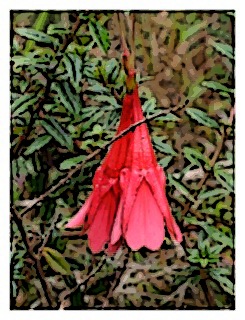
Section Fuchsia
(sixty-four species)
This is the largest section of Fuchsia, with its sixty-four species distributed primarily in cool montane cloud forest habitats in the tropical Andes from northern Argentina to Colombia and Venezuela. Two species, F. pringsheimii and F. triphylla, are endemic to Hispaniola. Except for F. rivularis subsp. pubescens and rivularis (Berry & Hermsen 1999), there are currently no taxa of subspecific rank recognized within this large section (Berry 1982). Fuchsia sec. Fuchsia consists of scandent or climbing shrubs, sub-shrubs or small trees with leaves that are opposite or whorled. The flowers are axillary and solitary, or held in racemes, panicles or involucrate clusters, and pendulous or divergent. The floral tube is 10 to 80 mm long. The annular nectaries are free from the floral tube and unlobed or weakly four- to eight-lobed, rarely with an uneven band lining the tube. The sepals are shorter than the floral tube and mostly in shades of red. The petals are also mostly in shades of red. The stamens occur in two unequal series. The pollen is yellow and the viscin threads are beaded. The seeds number fifty to 250.
This section's name, of course, is the same as the whole genus first described in honor of the German botanist Leonart Fuchs by Charles Plumier. Originally called Eufuchsia, from the prefix eu, meaning good or well, plus Fuchsia, the section was necessarily renamed Fuchsia since it contains the type species of the genus, Fuchsia triphylla.
Typus: Fuchsia triphylla L.
Synonym
Heterotypic
Fuchsia sect. Eufuchsia Baill., Hist. Pl. 6: 467. 1877.
Central Peru. Scattered in cloud forest thickets on the eastern slopes of the Andes from Libertad to Junín Departments at elevations from 1,500 to 2,700 meters.

Flowers—The few to numerous flowers are usually verticillately disposed in terminal arching racemes and have a narrowly funnelform tube 35 to 50 (to 60) mm long, which is bulbous at the base. The tube and sepals are bright orange red. Flowers few to numerous and usually verticillately disposed in terminal, arching racemes, rachis (8 to) 10 to 35 cm long, elongating in fruit, bracts lanceolate, divergent, 15 to 45 mm long, pedicels spreading at anthesis and 10 to 15 mm long, divergent and a
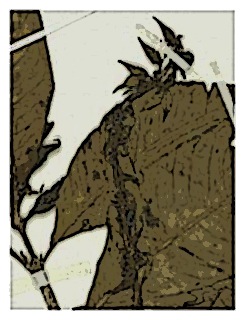
Fruit—The cylindrical-ellipsoid berry is 18 to 22 mm long and about 10 mm thick. It is purplish when ripe.
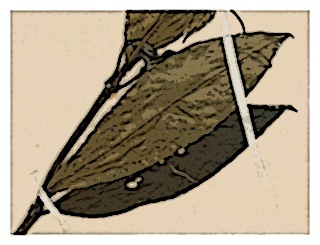
Seeds—The seeds are tan, 1.1 to 1.4 mm long and 0.8 to 1.0 mm wide.
Chromosomes—Gametic chromosome number n = 11.
Authors—I.M. Johnston, 1925.
Original publication—Contr. Gray Herb. 75: 37 1925.
Synonyms—F. aspiazui, J. F. Macbride 1941.
Herbarium Specimens & Occurences.
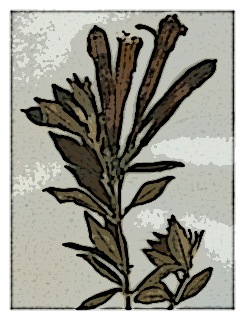
Ecuador. Along the Cordillera Occidental from Imbabura to Bolívar and one collection from the Nariño-Putumayo border in southern Colombia and growing in hedgerows on dry slopes, near streams or in upper elevation cloud forest at elevations from 2,850 or 3,000 to 3,500 meters.
Natural hybridization with F. vulcanica is known to occur.
Habit—This is an erect to scandent shrub 1 to 3 meters tall with mostly ascending branches, Young growth is conspicuously canescent to hirtellous with white hairs. Branchlets are 2 to 3 mm thick hirtellous to densely stirgose, green to dull purple. Older branches are a dull ash-gray.
Leaves—The ternate or occasionally quaternate leaves are narrowly elliptic to lanceolate, 40 to 90 or 120 mm long, matte green above and pale green below with red-purple veins. Leaves ternate or occasionally quaternate, often drooping, membranous, (narrowly) elliptic to lanceolate, acute to narrowly cuneate at the base, acute to subacuminate at the apex, 4 to 9 (to 12) cm long, 1.5 to 4 mm wide, matte green and strigose above, pale green and strigose-villous below with red purple veins; secondary veins 5-9(-11) on either side of the midvein; margin subentire to denticulate. Petioles strigose, 7-20 mm long, usually dull purple. Stipules lancelinear, 3-5 mm long, 0.5-1 mm wide, subpersistent.
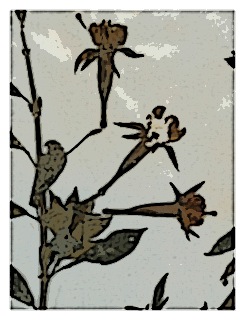
Flowers—The generally few pendant axillary flowers have a funnelform floral tube, 30 mm long, with a narrow tapered tip in bud, and are fully reflexed soon after anthesis. The tube and sepals are bright scarlet to orange-red. The rotund to orbicular or very broadly ovate petals are red to orange-red and (10 or) 13 to 18 mm long. The filaments are red or orange, the anthers cream, and the style and stigma both red. Flowers axillary and pendant, generally few, pedicels stout, 1-2 mm thick, 15-35(-50) mm long, strigose, ovary ovoid, usually constricted near the apex, 6 to 8 mm long, 3 to 4 mm wide, canescenthirtellous and slightly furrowed, floral tube funnelform, usually dilated above the middle, (32 to) 40 to 50 (to 65) mm long, 3 to 4.5 mm wide and bulbous at the base, tapered to 2 to 3 (to 4) mm wide in lower third, widened above until (6 to) 8 to 14 mm wide at the rim, strigose outside, villous inside for lower third, sepals lanceolate, narrowly acute at the apex, 16 to 23 (to 28) mm long, 6 to 8 mm wide, with a narrow, tapered tip in bud, fully reflexed soon after anthesis. Tube and sepals bright scarlet to orange red, petals red to orange red, rotund to orbicular or very broadly ovate, (10 to)13 to 18 mm long, (9 to)10 to 16 mm wide, rounded to obtuse at the apex, erect to suberect at anthesis. Nectary green, shallowly four to eight-lobed, circa 2 mm high, filaments red or orange, 10 to 18 mm and 8 to 13 mm long, anthers oblong, circa 4 mm long, 2 to 3 mm wide, cream, style red, densely villous from the base to the rim of the tube, stigma globose to subclavate, slightly four-cleft apically, 2 to 4 mm long, 2 to 4 mm wide, red.
Fruit—The ellipsoidal berry is 14 to 16 mm long and about 8 mm thick. It's usually more or less tetragonous before maturity, slightly verrucose, and red when ripe.
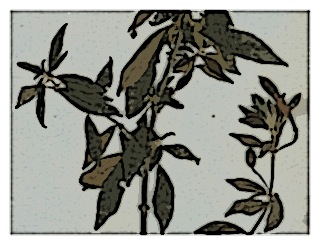
Chromosomes—Gametic chromosome number n = 11
Authors—Bentham 1845.
Original publication—Pl. Hartw. 178 1845.
Synonyms—None known.
Herbarium Specimens & Occurrences.
(Illustration—Botanical illustration of F. ampliata by Matilda Smith (1854–1926) in Curtis's Botanical Magazine, Vol. III (Series 3, Vol. 4), London, 1889, plate 6839.)
Southern Ecuador & Northern Peru. In Southern Ecuador and northern Peru in cloud forest and semi-open moist scrub in Piura, Cajamarca and Amazonas Provinces, Peru and in Zamora-Chinchipe Province, Ecuador at elevations from 1,130 and 1,800 to 3,000 meters.

Habit—This is a shrub 1 to 4 meters tall with terete branchlets, 3 to 8 mm thick, sparsely puberulent to strigillose, and older stems, 8 to 14 mm thick, with tan, finely striated bark.
Leaves—The opposite, or less often ternate, leaves are narrowly elliptic to obovate, (5 to) 7 to 17 cm long, 2 to 9 (to 11) cm wide, glabrous above, subglabrous to strigose below on midvein and along margin; secondary veins (8 to)12 to 15 on either side of the midvein; margin entire or subdenticulate. Petioles 6 to 20 (to 30) mm long. Stipules triangular, dark, 1.5 to 2 mm long, ca. 1.5 mm wide, subpersistent.
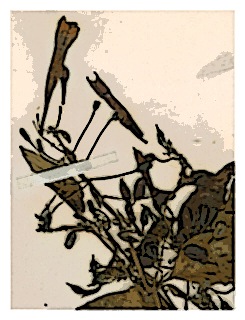
Fruit—The berry is oblong-ellipsoid, 10 to 12 mm long, 6 to 8 mm thick, and green to red.
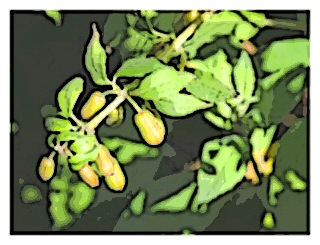
Seeds—Tan, 1 to 1.2 mm long, and 0.7 to 0.8 mm wide.
Chromosomes—Gametic chromosome number n = 11.
Authors—Johnston 1925.
Original publication—Contr. Gray Herb. 75: 31 1925.
Synonyms—F. osgoodii, J. F. Macbride 1941; F. ovalis var. aberans, J. F. Macbride 1941.
Herbarium Specimens & Occurrences.
Ecuador. Found in moist thickets in cloud forest and on humid slopes of Cerro Toledo east of Yangana and east of the Nudo de Cajanuma in Parque Nacional Podocarpus, Loja Province at elevations from 2,850 to 3,100 meters.
Habit—This is a well-branched shrub 0.8 to 1.2 meters tall. The branches are leafy along most of the stem with internodes 5 to 20 (to 60) mm long, lower stems that have somewhat protruding leaf scars and young growth that is conspicuously canescent-strigose.
Leaves— Opposite, three or occasionally four-whorled; blade membranous, elliptic to narrowly elliptic, 30 to 60 (to120) mm long, (15 to) 20 to 25 (to 40) mm wide, acute to narrowly acute at the apex, acute at the base, with whitish strigose trichomes loosely dispersed along the veins on both surfaces, upper surface lustrous dark green, lower surface paler green; margin gland-denticulate with trichomes between the teeth; secondary nerves 7 to 10 (to 12) on either side of the midvein; petiole 5 to 13 (to 20) mm long; stipules awl-shaped, 2 to 2.5 mm long, 0.3 to 0.5 mm wide, persistent, drying dark.
Flowers—Axillary and pendent in the upper leaf axils, uniformly red, two or three per node, the young buds canescent and usually held erect by the emerging leaves, pedicel 15 to 30 mm long, floral tube narrowly funnelform, 20 to 25 (to 30) mm long, 2 to 2.3 mm wide and slightly bulbous at the base, 4 to 6 mm wide at the rim, four- or eight-angled in cross-section, loosely strigose outside, villous in lower half inside, nectary a doughnut-shaped ring ca. 1.5 mm high and 2 mm wide at the base of the tube surrounding the style, ovary lightly four- or eight-angled, 5 to 6 mm long, 2 to 3 mm thick, strigose, sepals narrowly lanceolate, apiculate, (9 to) 12 to 15 mm long, 3 to 5 mm wide at the base, strigose on the outside, petals broadly elliptic to suborbicular, spreading at anthesis, 8 to 11 mm long, 6 to 9 mm wide, rounded to mucronate at the apex, cuneate at the base, style red, 28 to 36 mm long, villous in lower half, stigma whitish pink, capitate, slightly four-cleft at the apex, circa 2 mm high by 2 mm wide, filaments 5 to 6 mm and 3 to 4 mm long, anthers broadly oblong, circa 2 mm long and 1.5 mm wide, pollen white at dehiscence.
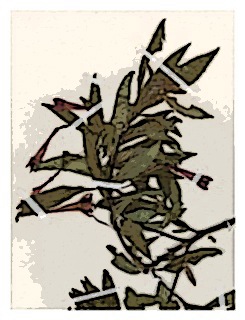
Seeds—The flattened seeds are semilunar in outline, 1.4 to 1.7 mm long and about 1 mm wide.
Chromosomes—Gametic chromosome number is unknown.
Authors—Berry 2007.
Original publication—Contr. Univ. Michigan Herb. 25: 167 2007.
Synonyms—None known.
Herbarium Specimens & Occurrences [Aarhus].
(Illustration—Details from a dried specimen of F. aquaviridis preserved at the Botanical Institute, Aarhus University, Denmark.)
Southern Peru & Bolivia. In upper cloud forest from southern Cuzco Department in Peru to just beyond the Bolivian border in La Paz Department, Bolivia at elevations from 2,600 to 3,500 meters
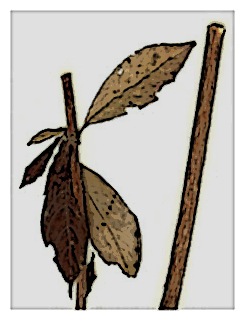
Habit—This is an erect to occasionally climbing shrub 2 to 4 meters tall with subcanescent to whitish-pilose young growth, purplish branchlets, and older branches exhibiting tan-brown splitting bark.
Leaves—Three- to five-verticillate, firmly membranous, acute to obtuse at the base, mostly acuminate at the apex, 2.5 to 8 cm long, 1 to 3 cm wide, dark green and subglabrous above, pale green and pubescent below, hairs usually denser along the midvein; secondary veins 5 to 9 on either side of the midvein; margin subentire to denticulate and sometimes slightly revolute. Petioles 3 to 12 mm long, reddish, densely pilose to lightly pubescent. Stipules linear-lanceolate, 2 to 4 mm long, 0.5 to 1 mm wide, subpersistent.

Flowers—Generally few and pendant from upper leafaxils, pedicels usually tuberculate, red, 14 to 35 (to 55) mm long, ovary tetragonous, 6 to 8 mm long, 1.5 to 2 mm thick, floral tube narrowly funnelform, walls ca. 1 mm thick, (25 to) 34 to 50 mm long, 4 to 6 mm wide at the base, then narrowed to 2 to 5 mm wide for lower ~, widened above until 10 to 12 mm wide at the rim, often more or less verrucose, glabrous to densely pilose outside, (densely) villous inside in lower ~-~, sepals lanceolate, acute to acuminate, thick-spongy, circa 1.5 mm thick when fresh, often verrucose, 15 to 20 mm long, 5 to 7 mm wide, spreading to divergent at anthesis. Tube and sepals scarlet, the tips sometimes dull purple green, petals deep red, usually drying a uniform purple, elliptic-obovate to suborbicular, 12 to 17 mm long, (7 to) 8 to 13 mm wide, rounded to broadly acute at the apex, spreading at anthesis. Nectary deeply four-lobed to unlobed, circa 2 mm high, filaments red, 10 to 14 mm and 7 to 10 mm long, anthers oblong, 3.5 to 4.5 mm long, 2 to 3 mm wide, white, style red, glabrous or with a few hairs, stigma subglobose, four-cleft at the apex, 2 to 2.5 mm long, ca. 3 mm wide, red pink, exserted 1 to 10 mm beyond the anthers.
Fruit—The berry is ellipsoid, reddish, tetragonous before maturity, 16 to 18 mm long, and 8 to 11 mm thick.

Seeds—The seeds are tan, 1.4 to 1.7 mm long and 0.8 to 1.1 mm wide.
Chromosomes—Gametic chromosome number n = 11.
Authors—Johnston 1939.
Original publication—J. Arnold Arbor. 20: 242 1939.
Synonyms—None.
Herbarium Specimens—Field Museum.
(Illustration thumbnail—For full image see ➤ F. austromontana, Field Museum, Neotropical Live Plant Photos, Photo ID Code 33364.)
Northern Peru and Southern Ecuador. In Cajamarca and Piura Departments of northern Peru and southernmost Loja Province

Habit—This is a suberect to scandent shrub 1.0 to 4.0 meters tall, with flexuous branches to several meters long when scandent. Its young growth is densely canescent-strigose or hirtellous with whitish hairs. Older portions are strigose to hirtellous. Older branches have brown exfoliating bark.
Leaves—Mostly ternate, occasionally quaternate, membranous, oblong to elliptic or narrowly elliptic-oblanceolate, acute at the base, acute to subacuminate at the apex, 6 to 15 (to 18) cm long, 2.2 to 5 (to 7) cm wide, matte green and strigillose above, paler and strigose below, sometimes red-tinged; secondary veins 7 to 12 on either side of the midvein, at times reddish below; margin subentire to denticulate. Petioles 6 to 20 (to 30) mm long. Stipules lanceolate to triangular, 1.5 to 2 mm long, mostly
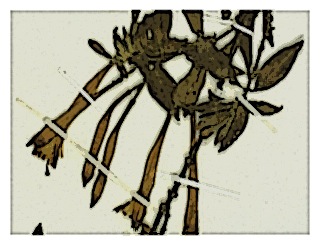

Flowers—Axillary at branch tips, pedicels 6 to 25 (to 50) mm long, drooping, ovary ellipsoid, 6 to 8 mm long, 2 to 3 mm thick, floral tube narrowly funnelform, (35 to) 40 to 55 mm long, 3 to 3.5 mm wide and bulbous at the base, narrowed to 2 to 2.5 mm wide above the nectary and gradually widened above until 5 to 8 mm wide at the rim, subtetragonous in transection, strigose outside, pilose inside in lower ~, sepals lanceolate, acuminate, 10 to 20 mm long, 4 to 6 mm wide, spreading to divergent at anthesis. Tube and sepals orange red, petals orange red, broadly elliptic-ovate, rounded to subacute at the apex, 7 to 11 long, 5.5 to 8 mm wide, mostly about half as long as the sepals. Nectary unlobed or shallowly quadrilobed, 1.5 to 2 mm high, filaments light red, 8 to 11 mm and 5 to 8 mm long, anthers oblong, 2.5 to 3 mm long, ca. 2 mm wide, white, style light red, pilose in lower ~, stigma subobconic, four-cleft apically, circa 3 mm long, 3 to 4 mm wide, light red.
Fruit—The ellipsoid berry is16 to 20 mm long, 8 to 0 mm thick, strigose, and reddish when ripe.
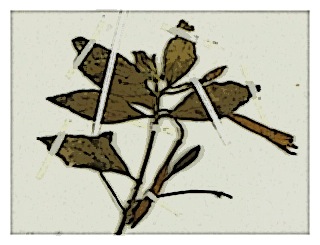
Seeds—1.3 to 1.6 mm long and 0.8 to 1.1 mm wide.
Chromosomes—Gametic chromosome number n = 11.
Authors—Humboldt, Bonpland & Kunth 1823.
Original publication—Nov. Gen. Sp. 6: 107 1823.
Synonyms—F. asplundii, J. F. Macbride 1941; F. townsendii, I. M. Johnston 1925.
Herbarium Specimens—Field Museum 1, Field Museum 2; Missouri 1, Missouri 2; Smithsonian 1, Smithsonian 2.
F. boliviana Carrière
Northern Argentina & Southern Peru. The probable native range of this species extends from northern Argentina to southern Peru in moist thickets in cloud forest at elevations from 600 and 1,000 meters to 3,000 meters.
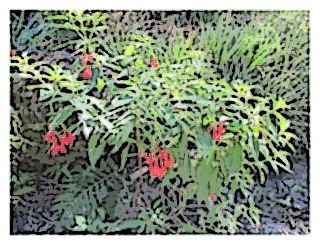
F. boliviana is widely naturalized in Colombia and Venezuela, as well as elsewhere outside South America in tropical and sub-tropical regions, having escaped from cultivation in Central America to Mexico, Jamaica, Hawaii, Reunion Island and India. This is likely because it stays in flower much of the year, self pollinates, reproduces by shoots, and tolerates much drier and harsher conditions than many other members of the genus.
Habit—This is an erect or bushy shrub or small tree, 2.0 to 4.5 or 6.0 meters tall, with arching-pendulous branches, Young growth is usually densely canescent with fine grey-white hairs. Terminal shoots are 2 to 4 mm thick, terete to angled. Older stems are woody, usually hollow, 1 to 6 cm thick, and exhibit tan-brown splitting bark.
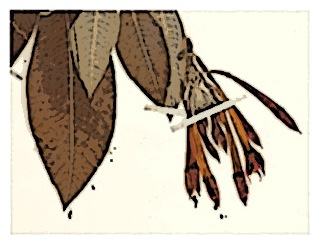
Leaves—Opposite, temate, or sometimes alternate near the uppermost branching nodes, softly membranous, narrowly to broadly elliptic or ovate, acute to rounded at the base, acute to acuminate at the apex, 5 to 20 (to 23) cm long, 3 to 12 (to 15) cm wide, medium to dark matte green and pubescent to subglabrous above, pale green and ashy puberulent to densely canescent below, especially along the nerves; secondary veins (12 to)15 to 25 on either side of the midvein, more or less impressed above, prominent and often reddish below; margin glandular-denticulate. Petioles pubescent, 2 to 5 (to 7) cm long. Stipules dark, narrowly lanceolate, 0.5 to 1.5 mm long, about 0.3 mm wide, deciduous.
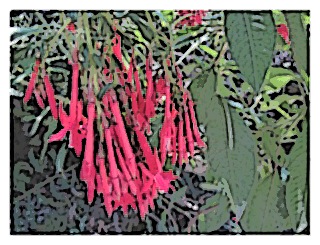
Flowers—Numerous in terminal, drooping racemes or few-branched panicles, the flowers congested near the tips, rachis 5 to 30 cm long in flower, 15 to 40 (to 60) cm long in fruit, bracts lanceolate, reflexed, 5 to 25 mm long, 2-8i mm wide, pedicels slender, pendant, pubescent, 5 to 12 (to 16) mm long, ovary cylindrical, 7 to 11 mm long, 2 to 3 mm thick, strigose to puberulent, floral tube narrowly funnelform (25 to) 30 to 60 (to 70) mm long, 1.5 to 3 mm wide and slightly bulbous at the base, gradually widened above until 4 to 7 (to 10) mm wide at the rim, pubescent outside, pilose inside for entire length, sepals lanceolate, acuminate, 10 to 20 mm long, 4 to 5 mm wide, tips apiculate in bud, initially spreading at anthesis, but soon becoming totally reflexed. Tube and sepals pale pink to bright scarlet, rarely pale white, petals scarlet, acute at the apex, more or less crispate with two to three longitudinal ridges, oblong to elliptic, 8 to 16 (to 20) mm long, 3 to 7 (to 9) mm wide, upper ~·recurved at anthesis, drying and dehiscing before the tube does. Nectary quadri-lobed, green, 2 to 3 mm high, filaments red, 8 to 15 mm and 5 to 10 mm long, anthers oblong, 2 to 3.5 mm long, 1 to 1.5 mm wide, white, style slender, pilose from the base to the rim of the tube, stigma capitate or clavate, subtetragonous, shallowly quadri-lobed at the apex, 2.5 to 3 mm long, 3 to 5 mm wide, cream, situated at the level of the antesepalous anthers or barely exserted beyond them.
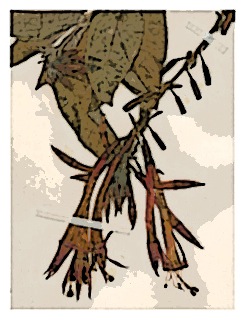
Fruit: The berry is cylindrical, 10 to 26 mm long, 8 to 14 mm thick, dark purple, strigose, and comestible.
Seeds—The seeds are tan, 1.3 to 2 mm long, 0.5 to 1 mm wide.
Chromosomes—Gametic chromosome number n = 11.
[NB: Stating that the species required further study, Dr. Paul Berry declined to recognize any varieties in Paul E. Berry. “The Systematics and Evolution of Fuchsia Sect. Fuchsia (Onagraceae).” Annuals of the Missouri Botanical Garden, 1982, Vol. 69, No. 1, pp. 1-199. He also indicated that the pale-flowered variety, Fuchsia boliviana 'Alba', is known only in cultivation. To date, there has been no subsequent publication of the species.]
Authors—Carrière 1877.
Original publication—Rev. Hort. 48: 150 1876.
Synonyms—F. boliviana var. boliviana, Carrière 1877; F. boliviana var. luxurians, Johnston 1925.
Herbarium Specimens—Arizona State; Edinburgh; Kew; New York 1, New York 2, New York 3, New York 4, New York 5; Smithsonian 1, Smithsonian 2.
Ecuador. In thickets, along streams and along roadsides in pasture zones on moist mountain slopes in Azuay and Loja Provinces, Ecuador, at elevations from 2,300 to 2,700 and 3,500 meters.
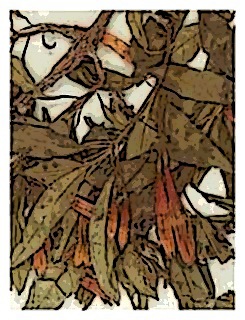
Habit—This is an erect to recumbent shrub 1.5 to 4 meters tall, well-branched with mostly ascending branches, punescent young growth, trichomes 0.1 to 4.5 mm long and appressed to erect. Its branchlets are terete to slightly angled. The older branches have purplish, exfoliating bark.
Leaves—Mostly in whorls of three or four, sometimes opposite or subopposite; blade membranous, narrowly elliptic, 3 to 9 cm long, 1 to 3 cm wide, acute to acuminate at the apex, acute at the base, subglabrous to sparsely strigose when young on both surfaces and margin, trichomes persisting mainly along the midvein and secondary nerves on lower surface when fully expanded, upper surface smooth, shiny, and light to dark green, lower surface paler green; margin nearly entire, usually with seven to ten glandular teeth projecting slightly from the edge especially in the upper half to two-thirds of the blade; secondary nerves (5 to) 8 to 10 on either side of the midvein; petiole strigose, (4 to) 6 to 25 mm long; stipules narrowly lanceolate when young, 1 to 1.5 mm long, about 0.2 mm wide, the tip quickly abscising and the thicker lower third persisting or abscising later.
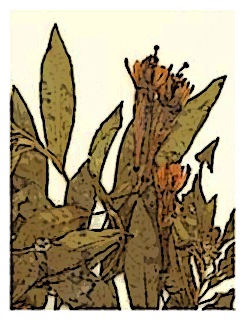
Fruit—The berries are oblong-ellipsoid before maturity and subrotund when ripe. They are 9 to 15 mm long and 5 to 9 mm thick.
Seeds—The flattened seeds are obtriangular in outline, 1.8 to 2.2 mm long, 1.2- to .6 mm wide. There are more-or-less 200 per fruit.
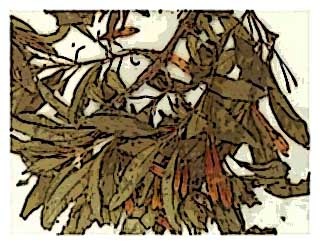
Chromosomes—Gametic chromosome number n = 11.
Authors—Berry 1995.
Original publication—Novon 5: 318 1995.
Synonyms—None.
Herbarium Specimens—New York 1, New York 2; MIssouri; Smithsonian.
(Illustration—Detail from herbarium specimen at the C. V. Starr Virtual Herbarium, New York Botanical Garden.)
Southern Colombia. Infrequent in wet subpáramo or upper cloud forest in Cauca, Huila, and Nariño Provinces at elevations from 2,800 to 3,350 meters.

Leaves—Three to five-verticillate, mostly quaternate, firmly membranous, (narrowly) elliptic to (ob-)ovate, acute to rounded at both ends, 4.5 to 10 cm long, 2 to 5 cm wide, medium to dark green and strigillose above, hirtellous to densely strigillose and paler below, with the midvein prominent and reddish; secondary veins 8 to 15 on either side of the midvein; margin subentire to denticulate. Petioles stout, 15 to 25 mm long, hirtellous, dull purple. Stipules 0.8 to 1 mm thick when fresh, lingulate to subterete in transection, subulate at the tip, 1.5 to 2 mm long, about 0.8 mm wide, divergent, occasionally connate, hirtellous, subpersistent.
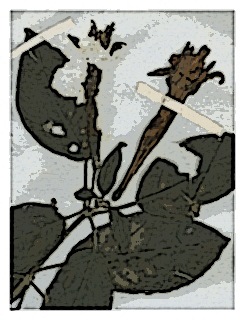
Fruit—The ellipsoid berry is 12 to 15 mm long, 8 to 10 mm thick, subtuberculate, and green to flushed purple;
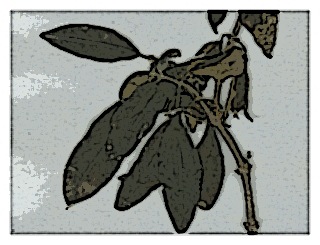
Seeds—The seeds are about 1.5 mm long and 0.6 to 0.8 mm wide.
Chromosomes—Gametic chromosome number n = 11.
Authors—Bentham 1845.
Original publication—Pl. Hartw. 179 1845.
Synonyms—None.
Herbarium Specimens—Kew 1, Kew 2.
Southern Colombia. In open thickets in high elevation elfin cloud forest, the eastern slopes of the Cordillera Central in Cauca, Huila, Nariño, and Putumayo Provinces, and in the Cordillera Occidental in the Farallones de Cali, Valle at elevations from 2,700 to 3,600 meters
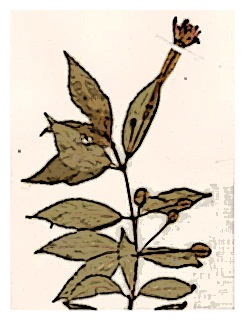
Habit—Usually few-branched shrubs (0.3 to) 0.5 to 2 m tall. Branchlets terete, 2 to 5 mm thick, subglabrous to strigose or puberulent, white green to red purple; older stems with subnitid, purple brown bark.
Leaves—Mostly ternate, occasionally opposite or quaternate, firmly membranous, (narrowly) elliptic to lance-ovate, acute to rounded at the base, mostly acuminate at the apex, (2.5 to) 3.5 to 7 (to 10) cm long, (1 to) 1.5 to 3.2 (to 4) cm wide, dark velvety green and subglabrous to sparsely strigose above, pale whitish green to deep flushed purple and strigose below; secondary veins (3 to) 5 to 6 (to 7) on either side of the midvein, subparallel and ascending towards the tip at about 45° to the midvein; margins serrulate with conspicuous glandular teeth, rarely subentire. Petioles glabrous to strigose, usually red purple, 2 to 13 (to 14) mm long. Stipules narrowly lanceolate to linear, 3 to 4 mm long, 0.5 to 1 mm wide, subpersistent.
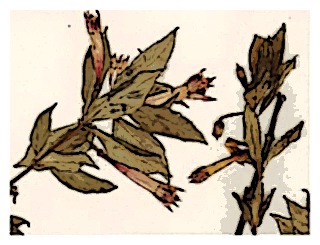
Flowers—Few in upper leaf axils, pedicels pendant, 12 to 28 mm long, ovary ovoid-ellipsoid, glabrous to puberulent or strigose, 5 to 6 mm long, 2.5 to 3 mm thick, floral tube narrowly funnelform, occasionally dilated in the middle and constricted again near the rim, 32 to 45 (to 54) mm long, 2 to 4 mm wide and slightly bulbous at the base, usually narrowed to 1.5 to 3 mm in lower ~, then widened to 4 to 11 mm wide at the rim, glabrous to strigose or puberulent outside, pilose inside for most or the entire length, sepals lanceolate, (sub-)acuminate at the apex, (12 to)14 to 17 (to 22) mm long, 5 to 6 mm wide, with a short point 1 to 2 mm long in bud, spreading at anthesis. Tube and sepals pink cerise to (light) purple lavender, young buds sometimes whitish green, petals usually considerably darker than the sepals, (dark) red-purple, elliptic-ovate, 9 to 11 (to 14) mm long, 5 to 6 (to 9) mm wide, obtuse to cuneate or sometimes mucronate at the apex, suberect at anthesis. Nectary unlobed, about 2 mm high, filaments pink, 8 to 10 mm and 5 to 7 mm long, anthers oblong, 3 to 4 mm long, 2 to 3 mm wide, yellow cream, style densely pilose from base to near the rim, red pink, stigma broadly capitate, tetragonous, slightly four-cleft apically, 2 to 3 mm long, 3 to 4 mm wide, pink, exserted 7 to 16 mm beyond the anthers.
Fruit—The berry is four-sulcate before maturity, glabrous to strigose or puberulent, subglobose at maturity, 11 to 13 mm long, 7 to 9 mm thick, and a lustrous red purple.
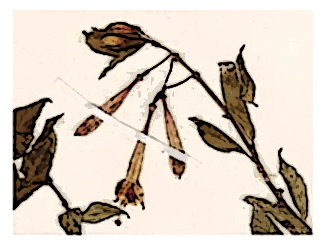
Seeds—Reddish brown to bright red, 2 to 2.5 mm long, 1.1 to 1.8 mm wide.
Chromosomes—Gametic chromosome number n = 11.
Authors—Berry 1982.
Original publication—Ann. Missouri Bot. Gard. 69: 118 1982.
Synonyms—None.
Herbarium Specimens—Kew; Missouri 1, Missouri 2, Missouri 3; New York; Smithsonian.
Peru. Very rare climber in cloud forest, known just from Panao and the Carpish area of Huánuco Department, Peru at elevations from 2,500 to 2,850 meters.
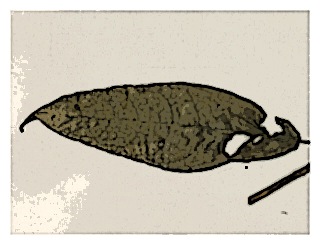
Habit—This is a climbing shrub or dangling liana in trees to 6 m above ground. The ultimate branches are pendant. The plants are glabrous except for the puberulent young flowers and pedicels.
Leaves—Opposite or ternate, firmly membranous, lanceolate to narrowly ovate, obtuse to unequal or slightly auriculate at the base, acuminate at the apex, 8 to 15 cm long, 4 to 6 cm wide, waxy green on both surfaces; secondary veins 7 to 10 on either side of the midvein; margin entire. Petioles reddish, slightly twisted, 2 to 20 mm long. The stipules are arrowly triangular, 1.5 to 2 mm long, about 0.7 mm wide, subpersistent.
Flowers—Held in simple, pendant, involucrate racemes, with two to three flowers per whorl and internodes 2 to 6 cm long, bracts thin membranous, concave, sessile, pruinose, broadly ovate, acuminate at the apex, clasping the stem at the base, 4 to 12 cm long, 1.5 to 5 cm wide, pedicels 7 to 15 mm long, ovary ellipsoid, about 7 mm long, about 3 mm thick, floral tube subcylindric to narrowly funnelform, (9 to) 10 to 13 cm long, bulbous and 6 to 7 mm wide at the base, narrowed to 3 to 5 mm wide above the nectary, slightly widened above until 8 to 9 mm wide at the rim, puberulent to subglabrous outside, pubescent inside in lower ~, sepals lanceolate, acuminate, 28 to 30 mm long, 6 to 7 mm wide, suberect at anthesis. Tube and sepals lavender to bright pink, tube white inside, petals crimson to dark purple, ovate, broadly acute, 5 to 7 mm long, about 4 mm wide, suberect at anthesis. Nectary light green, unlobed, about 3 mm high, filaments white pink, 13 to 14 mm and 9 to 10 mm long, anthers oblong, 4 to 5
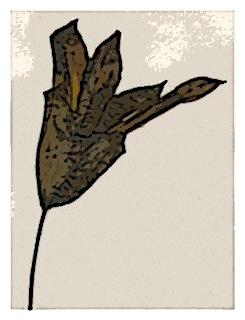
Fruit:—Unknown.
Seeds—Unknown.
Chromosomes: Gametic chromosome number n = 11.
Authors—Berry 1982.
Original publication—Ann. Missouri Bot. Gard. 69: 149 1982.
Synonyms—None.
Herbarium Specimens—Kew; Missouri.
Colombia and Ecuador. Known only from the base of Volcán Chiles along the Colombian-Ecuadorian border at elevations from 3,100 to 3,250 meters.
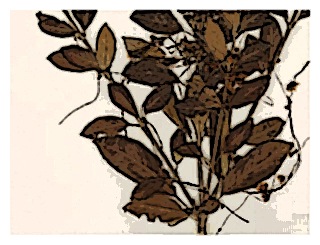
Habit—This is an erect to scandent, deciduous shrub 2 to 5 meters tall with densely cinereous-strigillose young growth, angled branchlets, 1 to 2.5 mm thick, and terete older branches with tan bark.
Leaves—Quaternate or less often temate, membranous, narrowly elliptic, acute at the base, acute to obtuse at the apex, 2 to 5 (to 7) cm long, 1 to 2 (to 3) cm wide, matte light green and strigillose above, paler and strigillose below; secondary veins 5 to 8 (to 9) on either side of the midrib, usually reddish brown; margin subdenticulate. Petioles strigillose, 5 to 12 (to 20) mm long. Stipules lanceolate, 1.5 to 2 mm long, about 0.5 mm wide, deciduous.
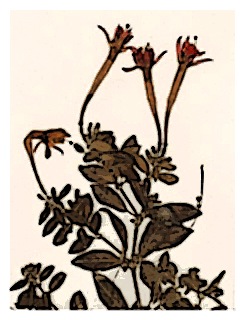
Fruit—The berry is ellipsoid to subglobose at maturity, canescent to velutinous, about 12 mm long, and about 10 mm thick.

Seeds—1.7 to 1.8 mm long and about 1 mm wide.
Chromosomes—Gametic chromosome number n = 11.
Authors—Berry 1982.
Original publication—Ann. Missouri Bot. Gard. 69: 184 1982.
Synonyms—None.
Herbarium Specimens—Kew; Missouri 1, Missouri 2; Smithsonian.
Bolivia. Scattered to locally frequent in cloud forest in Cochabamba and Santa Cruz Departments at elevations from 2,500 to 3,100 meters.
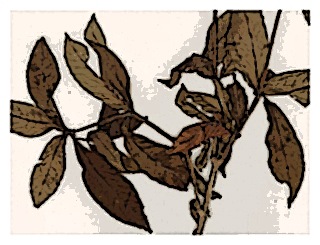
Habit—Shrubs on half to one and a half meters tall. Young growth subglabrous to puberulent.
Leaves—Ternate or less often quaternate, subsessile, firmly membranous, mostly elliptic or narrowly elliptic-lanceolate, acute to obtuse at the base, (sub to) acuminate at the apex, 3 to 12 cm long, 1 to 5 cm wide, subglabrous above, subglabrous to usually puberulent along the veins below and usually purple-flushed; secondary veins 11 to 14 on either side of the midvein; margin conspicuously dentate or serrate. Petioles 1 to 3 mm long. Stipules triangular, membranous when young to thick and recurved when old, 2 to 3 mm long, about 2 mm wide, subpersistent.
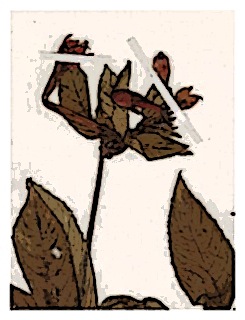
Fruit—Unknown.

Chromosomes—Gametic chromosome number is unknown..
Authors—Berry 1982.
Original publication—Ann. Missouri Bot. Gard. 69: 184 1982.
Synonyms—None.
Herbarium Specimens—Missouri; New York; Smithsonian.
Northern Peru. Endemic to cloud forest near high ridges of the mountains east of the Rio Utcubamba in Amazonas Department at elevations from 2,600 to 3, 200 meters.
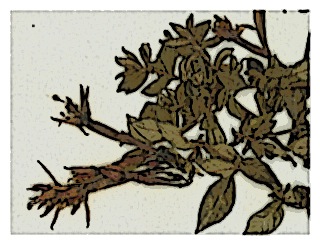
Habit—Densely-branched shrubs one to two and a half meters tall. Branchlets terete, 1.5 to 3 mm thick, usually less than 15 cm long, conspicuously ferrugineous-hirsute; older branches with red brown bark exfoliating in slender strips.
Leaves—Densely crowded on branchlets and upper portions of older stems with internodes mostly 2 to 5 mm long, 2 to 4 leaves per node, usually ternate, subcoriaceous, elliptic-ovate, rounded to acute at the base, acute at the apex, 8 to 12 mm long, 3 to 5 mm wide, glabrous on both sides except for scattered hairs 1.0 to 1.2 mm long on the basal portions of the midvein or along the
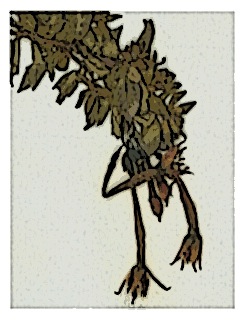
Flowers—Mostly two to eight, drooping, grouped in uppermost axils at the branch tips, pedicels hirsute, 9 to 15 mm long, ovary oblong, 4 to 5 mm long, 1.5 to 2 mm thick, pilose, eight-sulcate, floral tubes narrowly funnelform, 35 to 50 mm long, 2 to 4 mm wide and slightly bulbous at the base, narrowed to 1.5 to 3 mm wide above the nectary, gradually widened above until 7 to 10 mm wide at the rim, glabrous to sparsely pilose outside, pilose inside for most its length, sepals narrowly lanceolate, acuminate, 13 to 18 mm long, 4 to 5 mm wide, with tips connate into a tip about 2 mm long in bud. Tube and sepals red, petals red, narrowly triangular with long, tapered tips, 9 to 14 mm long, 2.5 to 3 mm wide, ~-~ shorter than the sepals. Nectary unlobed, about 1.5 mm high, filaments red, 6 to 10 mm and 4 to 7 mm long, anthers oblong, 2 to 2.5 mm long, about 1.5 mm wide, style red, densely pilose for most its length, stigma subobconic, four-cleft at the apex, 2 to 3 mm long, about 2 mm wide, exserted 4 to 5 mm beyond the anthers.
Fruit—The berry is ellipsoid-ovoid, about 10 mm long, and 5 to 7 mm thick.
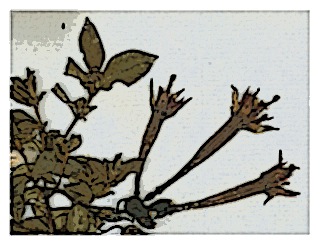
Seeds—Tan, 1.8 to 2.1 min long, and 1 to 1.2 mm wide.
Chromosomes—Gametic chromosome number is unknown.
Authors—Fielding & Gardner 1844.
Original publication—Sert. Pl. t. 28 1844.
Synonyms—F. dolichantha, Krause 1905.
Herbarium Specimens—Kew 1, Kew 2.
Central Peru. Known only from Pasco Department near the Huánuco border.
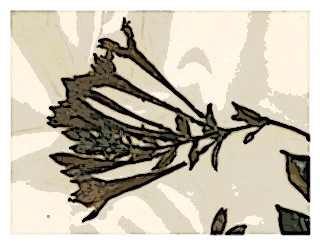
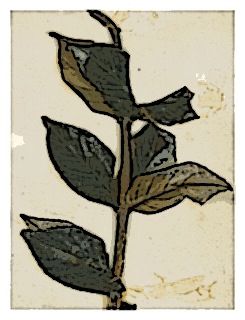
Authors—Berry1982, Berry 1988.
Original publication—Ann. Missouri Bot. Gard. 69: 150 1982.
Synonyms—None.
Herbarium Specimens—Kew.
Southern Colombia and Northern Ecuador. Found in high elevation cloud forest and subpáramo areas from the Cordillera Central of Colombia in Cauca south to Imbabura, Ecuador, at elevations from 2,800 to 3,800 meters.
There is considerable variation in some populations of this species that might be the result of hybridization with F. caucana.
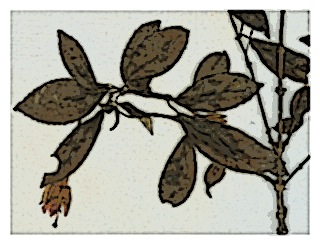
Habit—Erect to scandent shrubs 0.5 to 5 meters tall with ascending to divergent branches. Branchlets terete, 2 to 3 mm thick, strigose, generally red purple; older stems 5 to 12 mm thick with red tan, exfoliating bark.
Leaves—Ternate or less often quaternate, firmly membranous to subcoriaceous, elliptic to oblanceolate, acute to narrowly cuneate at the base, acute to obtuse at the apex, 20 to 70 mm long, 7 to 30 mm wide, dark glossy green and glabrous to strigose above, pale green and usually strigose or villous below; secondary veins 3 to 8 on either side of the midvein, often red below; margin gland-serrulate, the teeth usually conspicuous and mostly 0.3 to 0.5 mm long. Petioles strigose, 3 to 12 (to 22) mm long. Stipules lance-linear, dark, 2 to 4 mm long, 0.7 to 1 mm wide, persistent and usually divergent.
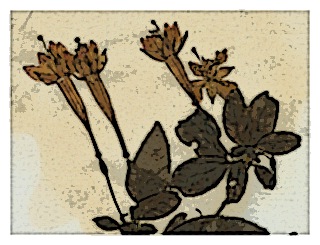
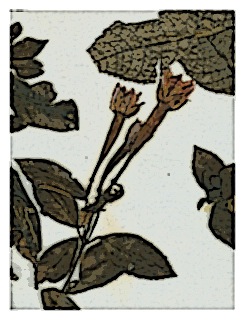
Fruit—The berry is subglobose, 9 to 13 mm long, 8 to 10 mm thick, and purple at maturity.
Seeds—Tan, 2 to 2.6 (to 3) mm long, and (1.0 to) 1.2 to 1.6 (to 2) mm wide.
Chromosomes—Gametic chromosome number n = 11, 22.
Authors—Bentham 1845.
Original publication—Pl. Hartw. 179 1845.
Synonym—F. colombiana, Munz 1946.
Herbarium Specimens—Edinburgh; Kew 1, Kew 2.
Distrubution—Central Peru. Endemic to cloud forest on the eastern slopes of the central Peruvian Andes in Huánuco, Junín, and Huancavelica Departments at elevations from (1,500 to) 2,250 to 2,850 meters.
The plant called F. corymbiflora var. alba is a hybrid and the species itself is often confused with F. boliviana.
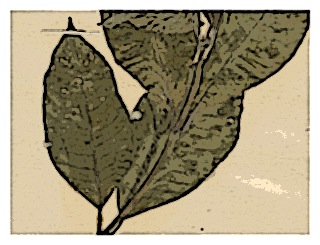
Habit—Scandent to erect shrubs 1 to 4 meters tall. Young growth finely canescent to puberulent; older stems and leaves velutinous to subglabrous; branches few and spreading, branchlets terete, 2 to 3 mm thick, red to dull purple.
Leaves—Opposite, very rarely ternate, firmly membranous, elliptic to oblong, acute at the base, acute to acuminate at the apex, 6 to 12 (to 19) cm long, 3 to 6 (to 9) cm wide, matte green above, pale green below; secondary veins 13 to 17 on either side of the midvein, sometimes reddish below; margin subentire to obscurely glandular-denticulate. Petioles 6 to 20 (to 30) mm long. Stipules triangular, 1 to 2 mm long, about 1.5 mm wide, sometimes connate, deciduous.
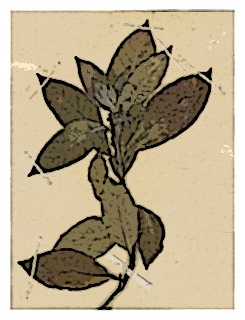
Flowers—Few to many in terminal, corymbose, arching to drooping racemes or few-branched panicles, rachis 2 to 8 cm long, bracts lanceolate, 5 to 15 mm long, Pedicels pendant to ascending in fruit, 6 to 15 mm long, ovary ellipsoid, 5 to 6 mm long, about 2 mm thick, puberulent, floral tube narrowly funnelform, 40 to 65 (to 70) mm long, 2 to 2.5 mm wide and bulbous at the base, narrowed to 1.5 to 2 mm wide for about the basal 10 mm of the tube, then gradually widened above until 5 to 8 mm wide at the rim, minutely pubescent under a lens to velutinous or strigillose outside, pubescent inside for most of length, sepals lance-oblong, 12 to 15 mm long, 3.5 to 5 mm wide, acute at the apex, buds terete and slightly mucronate, spreading-divergent at anthesis. Tube and sepals pale pink to bright scarlet, petals darker, redo, oblong, acute to obtuse-tipped, 12 to 17 mm long, 4 to 5 mm wide, spreading and equal to or longer than the sepals at anthesis. Nectary shallowly 4-lobed, about 1.5 mm high, filaments pink to red, 8 to 10 mm and 5 to 7 mm long, anthers oblong, 2.5 to 3 mm long, about 1.5 mm wide, white, style pink, puberulent from the base to the rim of the tube, stigma capitate, 4-cleft at the apex, 2 to 2.5 mm long, about 2.5 mm wide, cream, exserted 3 to 6 mm beyond the anthers.
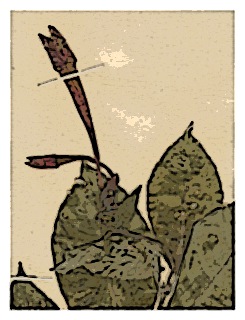
Fruit—The berry is subglobose, more-or-less tetragonous before maturity, 10 to 12 mm long, 8 to 10 mm thick, and red.
Seeds—Reddish tan, 1.8 to 2.1 mm long, and 1 to 1.4 mm wide.
Chromosomes—Gametic chromosome number n = 11.
Authors—Ruiz & Pavon 1802.
Original publication—Fl. Peruv. 3: 87 1802.
Synonyms—F. munzii, J. F. Macbride 1941; F. velutina, I. M. Johnston 1925.
Herbarium Specimens—Field Museum; California Academy; Kew; Smithsonian.
Colombia. Central Colombia. An infrequent shrub in cloud forest thickets of the Nevado de Ruiz Massif in the Cordillera Central, in Tolima, Quindio, and Caldas Departments at elevations from 2,600 to 3,000 meters.

Habit—Suberect to scandent shrubs one to three meters tall. Young branches conspicuously 3 to 6ridged, one ridge for each leaf in the whorl above, 3 to 9 mm thick, green, strigillose to subcanescent; older branches terete with dull gray brown, exfoliating bark.
Leaves—3 to 6-verticillate, mostly in whorls of 4 or 5, firmly membranous, elliptic to broadly oblanceolate, acute to obtuse at the base, acute to acuminate at the apex, 6 to 16 cm long, 2.5 to 7 cm wide, sparsely strigose and velvety dark green above, strigose and paler to purple flushed below, especially on and along the prominent midrib; secondary veins 10 to 15 on either side of the midvein; margin glandular-serrulate and usually purple tinged. Petioles stout, 2 to 3.5 mm thick, 12 to 40 mm long, sparsely strigose, green to pink red. Stipules conspicuous, subtriangular, divergent, margins and tips recurved on lower nodes, separate to fully connate, thick-callose, 2.5 to 4 mm long, about 3mm wide when fresh, each stipule with a central longitudinal nerve 2 to 3 mm thick, considerably flattened and shrunken when dry, persistent.
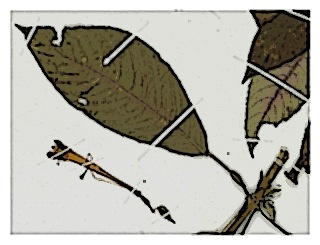
Flowers—Numerous in terminal or subterminal racemes or verticillately branched panicles, rachis ridged, spreading to drooping, 5 to 30 cm long, bracts 8 to 20 mm long, pedicels short, pendant, 3 to 8 mm long, ovary cylindrical, 5 to 8 mm long, 2 to 4 mm thick, green, strigose, floral tube narrowly funnelform, 32 to 46 (to 48) mm long, 3 to 5 mm wide and bulbous at the base, narrowed to 2 to 3 mm wide above the nectary, then gradually widened above until 5 to 8 mm wide at the rim, finely strigose outside, pilose inside in lower ki, Sepals lanceolate, acute, 10 to 14 mm long, 4 to 6 mm wide, with a short tip 1 to 2 mm long in bud, spreading at anthesis. Tube subnitid scarlet pink, sepals similar but becoming dull purple towards the tip, petals deeper red, narrowly elliptic-oblong, acute and more-or-less mucronate at the apex, 11 to 16 (to 18) mm long, 3 to 5 (to 6) mm wide, spreading at anthesis. Nectary green, unlobed, about 2 mm high, 0.8 to 1 mm thick, filaments 711mm and 4 to 7 mm long, anthers oblong, 2.5 to 3 mm long, about 1.5mm wide, white, style glabrous, pink, stigma globose, four-parted at the apex, 3 to 4 mm long, 2 to 3 mm wide, bright red pink, exserted 3 to 8 mm beyond the anthers.
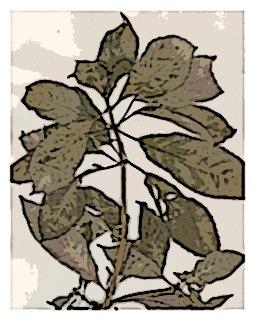
Fruit—The berry is cylindric to subglobose when fully ripe, 13 to 15 mm long, 9 to 13 mm thick, and nitid green to flushed purple.
Seeds—ca. 1.5 mm long, and 0.8 to 1.1 mm wide.
Chromosomes—Gametic chromosome number n = 11.
Authors—Berry 1982.
Original publication—Ann. Missouri Bot. Gard. 69: 181 1982.
Synonyms—None.
Herbarium Specimens—Kew; MIssouri; Smithsonian.
Colombia. Infrequent in moist, open thickets in cloud forest on eastern slopes of the Andes from Caqueta south to Putumayo at elevations from 1,400 to 2,200 meters.
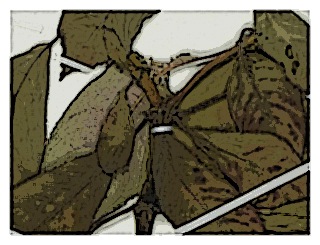
Habit—Subshrubs one half to one and a half meters high. Branchlets terete to slightly flattened, 2 to 6 mm thick, subglabrous, green to reddish purple; older branches with light tan-gray bark.
Leaves—Opposite, elliptic, firmly membranous, acute at both ends, smooth and glossy above, subglossy and finely strigillose below on veins and margins; secondary veins 8 to 12 on either side of the midvein, more-or-less impressed above, at times purple tinged below; margin subentire. Petioles stout, sparsely strigose, 4 to 14 (to 17) mm long, red purple. Stipules triangular, firm, dark purple, 1 to 2 mm long, about 1.5 mm wide, subpersistent.
Flowers—Few to many in a compact, terminal, drooping raceme, rachis 1 to 5 (to 8) cm long, bracts lanceolate, 8 to 18 mm long, reflexed, pedicels 7 to 13 mm long, ovary oblong, 4 to 7 mm long, 1.5 to 2.5 mm thick, strigillose, subnitid red purple, floral tube narrowly funnelform, (28 to) 35 to 50 (to 55) mm long, slightly nodose and 2 to 3.5 mm wide at the base, narrowed to 1.5 to 3 mm wide in lower ~ and widened above until 6 to 8 mm wide at the rim, puberulent outside, pubescent inside in lower ~, sepals lanceolate, acuminate, (8 to) 10 to 20 mm long, 4 to 6 mm wide, tips usually free in bud for 2 to 4 mm. Tube and sepals nitid red to orange red, petals orange red, elliptic to oblanceolate, 9 to 15 mm long, 4 to 6 mm wide, acute at the apex, spreading at anthesis, Nectary unlobed, about 1.5 mm high, filaments orange red, 5 to 9 mm and 4 to 5 mm long, anthers oblong, 2 to 3 mm long, 1 to 1.5 mm wide, style sparsely villous in lower ~, orange red, stigma capitate, tetragonous, 4-lobed in upper ~, 2:-3mm long, 2 to 3 mm wide, cream, exserted 1 to 4 mm beyond the anthers.
Fruit—The berry is ellipsoid, 15 to 20 mm long, 10 to 15 mm thick, and lustrous red purple.
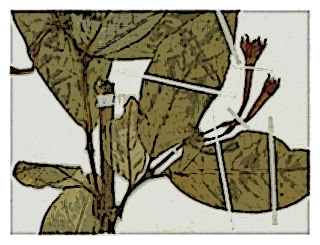
Seeds—1.1 to 1.3 mm long, and 0.6 to 0.8 mm wide.
Chromosomes—Gametic chromosome number unknown.
Authors—Munz 1943.
Original publication—Proc. Calif. Acad. Sci. IV, 25: 51 1943.
Synonyms—None.
Herbarium Specimens—Smithsonian.
Peru. A scattered to locally frequent shrub in thickets from tree line to mid-elevation cloud forest, from San Martín to Cuzco Departments at elevations from 2,900 to 3,400 meters.
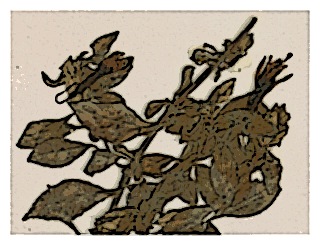
Habit—Suberect to scandent shrubs one to three meters tall with a well-developed system of lateral, divaricate, often horizontal branches. Secondary and tertiary branches numerous, 2 to 4 per node and held at near 90° to stem, densely ferrugineous-tomentose to canescent; older stems 5 to 14 mm thick with sublustrous, copper red bark exfoliating in long, uneven strips.
Leaves—Opposite or mostly ternate, firmly membranous, lanceolate to elliptic-obovate, acute to attenuate at the base, acute at the apex, 15 to 35 (to 45) mm long, 7 to 15 mm wide, usually dark green and subglabrous to strigillose above with impressed veins, paler below with strigose, usually reddish hairs along the veins; secondary veins 4 to 6 on either side of the midvein, subelevated below, higher order veins not visible without magnification, margin subentire to serrulate or denticulate. Petiole 3 to 10 (to 14) mm long, canescent to tomentose. Stipules filiform, 2 to 3 mm long, about 0.3 mm wide, mostly deciduous.
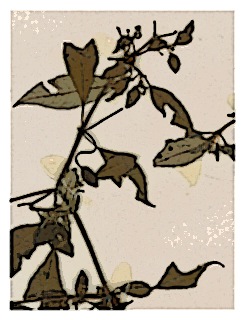
Flowers—Axillary and few to numerous towards the tips of branches, pedicels slender, strigose, at times slightly verrucose, arching-pendant, 15 to 25 mm long, ovary oblong, 2 to 3 mm long, 1 to 1.5 mm thick, floral tube subcylindric, 10 to 20 (to 23) mm long, 3 to 4 mm wide at the base, usually slightly narrowed to 2.5 to 3 mm wide above the nectary and slightly widened above to 4 to 6 mm wide at the rim, subglabrous to strigillose and occasionally verrucose outside, densely villous inside in lower ~-~, sepals narrowly lanceolate, 8 to 10 (to 18) mm long, 2 to 3 (to 4) mm wide, narrowly acute at the apex, not much wider than the tube in bud, spreading at anthesis. Tube red to dark red, sepals red with dull green tips in bud, petals scarlet to orange red, linear to broadly elliptic-ovate and often variable on the same plant, 5 to 9 (to 14) mm long, 1.5 to 4 (to 8) mm wide, apex acute. Nectary unlobed to obscurely 4-lobed, 1 to 1.5 mm high, filaments red, 8 to 10 mm and 5 to 8 mm long, anthers oblong, 2 to 2.3 mm long, 1.2 to 1.5 mm wide, dull white, style glabrous, red, stigma clavate to capitate, about 2 mm long and 1 to 2 mm wide, obscurely 4-cleft, white, exserted 4 to 8 mm beyond the anthers.
Fruit—The berry is subglobose, subtetragonous before maturity, 8 to 9 mm long, 5 to 6 mm thick, and red.
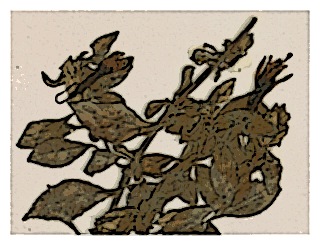
Seeds—Tan, 1.5 to 1.6 mm long, 0:8 to 1.0 mm wide.
Chromosomes—Gametic chromosome number is unknown.
Authors: Ruiz & Pavon 1802.
Original publication—Fl. Peruv. 3: 88 1802.
Synonyms—F. fusca, Krause 1906; F. scandens, Krause 1905.
Herbarium Specimens—Field Museum 1; New York.
Peru and Bolivia. From three main areas: 1. The Pacific slopes of the Cordillera Occidental of Peru in Lima and Ancash near springs and in moist canyons at elevations from 2,800 to 3,500 meters; 2. The eastern slopes of the Peruvian Andes from Huánuco to Cuzco in cloud forest and moist upland shrub vegetation at elevations from 2,500 to 3,400 meters; and 3. The northeastern slopes of the Bolivian Andes in La Paz and Cochabamba Departments in cloud forest at elevations from 2,200 to 3,100 meters.
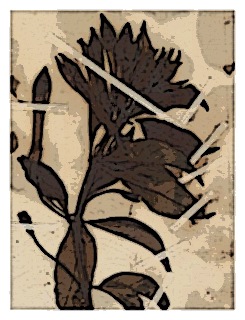
Habit—Erect to scandent shrubs one and a half to four meters tall or climbing in trees to ten meters above ground. Young growth subcanescent or occasionally pilosulous; branchlets terete, subdivaricate, green to wine red; older branches 5 to 20 mm thick with tan, exfoliating bark.
Leaves—Three to five-verticillate, mostly ternate or quatemate, rarelyopposite, firmly membranous, (narrowly) elliptic to oblanceolate, acute to narrowly cuneate at the base, acute to subacuminate at the apex, 4 to 17 cm long, 1.5 to 6.5 cm wide, dull to nitid dark green and glabrous above, pale green and subglabrous to strigose mostly along veins and margins below; secondary veins 7 to 17 on either side of the midvein, often reddish below; margin denticulate. Petioles glabrous to loosely strigose, (5 to) 8 to 20 (to 25) mm long. Stipules triangular, firm, often connate, 2 to 2.5 mm long, about 1.5 mm wide, deciduous.
Flowers—Few to numerous, axillary and pendant, usually grouped toward branch tips, pedicels stout, smooth, 1 to 1.5 mm thick, 18 to 45 mm long, suberect in bud, drooping at anthesis, generally green, ovary narrowly oblong, terete, 10 to 13 mm long, 3 to 4.5 mm thick, generally glabrous, green, floral tube subcylindric, firm, walls 1 to 1.5 mm thick, smooth, (28 to) 36 to 47 mm long, (3 to) 4 to 8 mm wide at the base, sometimes very slightly narrowed above the nectary, straight or slightly widened above until (5 to) 6 to 12 mm wide at the rim, glabrous to puberulent outside, densely villous inside above the nectary for 7 to 10 mm, glabrous above, sepals lanceolate, acuminate, 17 to 26 mm long, 4 to 7 mm wide, forming a tapered point in bud, spreading to subdivergent at anthesis. Tube waxy light pink, lavender, or light red, sepals pink to light red with light green to whitish tips or margins, at times entirely whitish green, petals orange to scarlet,. usually drying purple streaked, lance-oblong to oblanceolate, obtuse to broadly acute at the apex, slightly undulate, 14 to 18 mm long, 4 to 6 (to 7) mm wide, suberect at anthesis. Nectary green, unlobed, 2.5 to 3 mm high, about 1.5 mm thick, filaments pink to light. red, 14 to 23 mm and 8 to 18 mm long, anthers oblong, 4 to 6 mm long, 2 to 3 mm wide', white, style stout, pink to light red, glabrous, stigma subclavate, subentire (very slightly 4-cleft at the apex), 3 to 4 mm long, 2 to 3.5 mm wide, dull white, exserted 2 to 12 mm beyond the anthers.
Fruit—The berry is ellipsoid, 20 to 26 mm long, 10 to 12 mm thick, nitid green to red purple, and smooth surfaced.
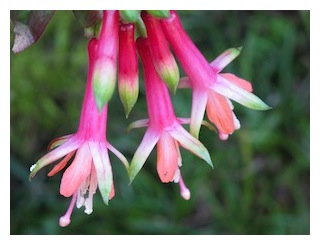
Chromosomes—Gametic chromosome number n = 11.
Authors—Ruiz & Pavon 1802.
Original publication—Fl. Peruv. 3: 88 1802.
Synonyms—F. leptopoda, Krause 1905; F. serratifolia, Ruiz & Pavon 1802; F. siphonatha, Krause 1905; F. tacsoniiflora, Krause 1905.
Herbarium Specimens—Field Museum 1, Field Museum 2, Field Museum 3; Missouri 1, Missouri 2.
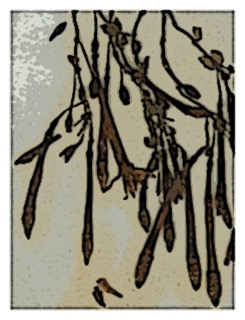
Southern Colombia to Central Ecuador. In cloud forest on the west slopes of the Cordillera Occidental of the Northern Andes from Carchi to Pichincha and on the east slopes of the Cordillera Central in Imbabura and Carchi; also in the drier Central Valley of Ecuador from Pichincha to Carchi and in the Nudo de Pasto area in Nariño, Colombia, occurring commonly in hedgerows, at elevations from 2,400 to 3,300 meters.
Habit—Erect to usually scandent-climbing shrubs two to ten meters high, with arching to hanging branches 0.5 to 3 meters long. Branchlets canescent, dull red, 2 to 8 mm thick, with tan bark exfoliating in longitudinal strips.
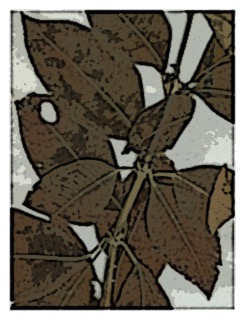
Flowers—Numerous in dense, drooping, terminal panicles or series of terminal and subterminal, corymbiform racemes, rachis 2 to 6 cm long when young, 8 to 25 cm long in fruit, bracts elliptic, 5 to 20 mm long, 3 to 10 mm wide, short-petiolate, sometimes reflexed, pedicels slender, pendant, incanous, 5 to 10 mm long, ovary ellipsoid, 5 to 7 mm long, 2 to 3 mm thick, floral tube narrowly funnelform or subcylindric, 40 to 50 mm long, 3 to 4
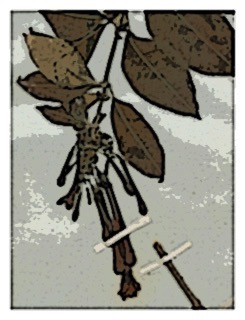
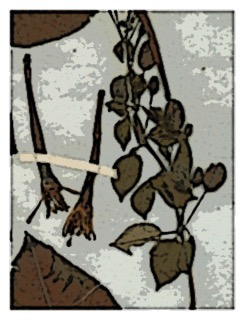
Fruit—The berry is ellipsoid, puberulent, 12 to 16 mm long, and 7 to 12 mm thick.
Seeds—Tan brown, 1 to 1.2 mm long, and about 0.6 mm wide.
Chromosomes—Gametic chromosome number n = 11.
Authors—Hooker 1837.
Original publication—Hooker's Icon. Pl. 1: t. 65 1837.
Synonyms—None.
Herbarium Specimens—Kew.
Central Peru. Locally frequent in openings of the cloud forest from San Martín to Junín Departments at elevations from 2,600 to 3,150 meters.
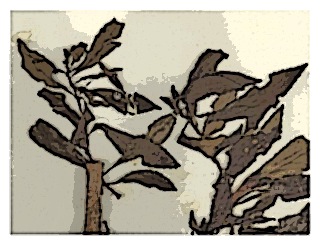
Habit—Erect to climbing-scandent shrubs on to three meters tall with horizontally divergent to arcuate branches one half to one and a half meters long. Branchlets subcanescent to coarsely strigose with reddish hairs; older branches with finely fissured, dull tan to coppery bark.
Leaves—In whorls of three or four, occasionally opposite or subopposite, membranous, elliptic to obovate, acute to attenuate at the base, acute at the apex, 2 to 8 cm long, 1 to 3 cm wide, velvety dark green and strigillose above, strigose below especially along veins and often flushed with a bluish tinge; secondary veins 6 to 10 on either side of the midvein, higher order veins reticulate and usually visible without magnification; margin moderately to strongly glandular-serrulate. Petiole pubescent, 4 to 12mm long. Stipules filiform, 2 to 4 mm long, about 0.4 mm wide, deciduous.
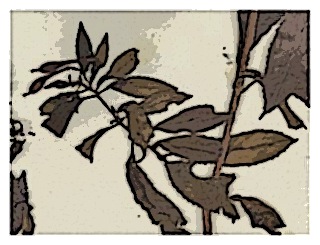
Flowers—Axillary and numerous towards the branch tips, pedicels slender, pendant, 12 to 30 mm long, ovary oblong, about 3 mm long, floral tube narrowly funnelform, (15 to) 22 to 28 mm long, 3 to 4 mm wide and conspicuously nodose at the base, then more-or-less abruptly narrowed to about 2 mm wide above the nectary and gradually widened above until (6 to) 8 to 9 mm wide at the rim, strigillose to pilose outside, glabrous inside, sepals narrowly lanceolate, (10 to) 14 to 16 mm long, about 3 mm wide, acuminate, often with free tips in bud, divergent at anthesis. Tube and sepals dark red to deep violet (blue red), petals red to violet, elliptic, usually about half as long as the sepals, 7 to 9 mm long, about 3 mm wide, acute at the apex. Nectary unlobed, about 1.5 mm high, filaments red to violet, 9 to 13 mm and 5 to 9 mm long, anthers oblong, about 2 mm long, about 1.5 mm wide,
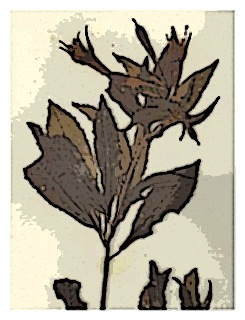
Fruit—The berry is ellipsoid to subglobose, about 12 mm long, about 8 mm thick, and lustrous purple.
Seeds—1 to 1.2 mm long, and about 0.6 mm wide.
Chromosomes—Gametic chromosome number n = 11.
Authors—Berry 1982.
Original publication—Ann. Missouri Bot. Gard. 69: 79 1982.
Synonyms—None.
Herbarium Specimens—Field Museum 1, Field Museum 2; Kew; MIssouri 1, Missouri 2; New York; Smithsonian.
F. fontinalis Macbr.
Northern Peru. In thickets, banks, and stream sides, and in Amazonas Department in upper cloud forest on the east side of the Jalca de Calla-Calla and in the mountains to the east of the Rio Utcubamba, at elevations from 2,900 to 3,400 meters.
Habit—Erect to scandent shrubs one half to four meters tall with spreading branches. Young growth canescent to densely pilose, often becoming ferrugineous with age; branchlets pilulose to tomentose; older branches 5 to 12 mm thick with tan, finely fissured bark.
Leaves—whorled, mostly ternate or quaternate, occasionally opposite, membranous, elliptic to (ob to) lanceolate, acute to attenuate at the base, acute at the apex, 35 to 110 mm long, 10 to 35 mm wide, strigillose above and along the veins below, basal leaves noticeably larger than the upper ones; undersurface visibly reticulate-veined, secondary veins 8 to 14 on either side of the midvein; margin conspicuously denticulate or serrate. Petioles pubescent, 5 to 21 mm long, mostly reddish. Stipules filiform, 2 to 3 mm long, about 0.4 mm wide, deciduous to semipersistent.
Flowers—Numerous and generally densely grouped in upper leaf axils or in racemes or many branched terminal panicles, rachis 3 to 14 cm long with reduced leaves 15 to 25 mm long subtending the flowers, pedicels slender, pendant, pubescent, 6 to 16 (to 25) mm long, floral tube subcylindric to narrowly funnelform, 15 to 28 mm long, 3 to 4 mm wide and somewhat bulbous at the base, then constricted to about 2 mm wide above the nectary and widened gradually above until 4 to 6 mm wide at the rim, pilose to strigillose outside, glabrous inside, sepals lanceolate, 10 to 13 mm long, about 3 mm wide, acuminate, spreading-divergent at anthesis. Tube and sepals nitid red or pink, petals red, usually noticeably shorter than the sepals, lanceolate, 6 to 9 mm long, 2 to 3 mm wide, acute, spreading at anthesis. Nectary 4 to 8-lobed, about 1.5 mm high, filaments pink to red, 9 to 14 mm and 6 to 10 mm long, anthers oblong, 2 to 2.5 mm long, 1 to 1.5 mm wide, dull white, style light red, glabrous, stigma capitate, slightly 4-lobed, 1.5 to 2 mm long and wide, exserted 2 to 4 mm beyond the anthers.
Fruit—The berry is subglobose, 9 to 10 mm long, 5 to 9 mm thick, and red.
Seeds—Tan, 1 to 1.2 mm long, about 0.7 mm wide.
Chromosomes—Gametic chromosome number n = 11.
Authors—Macbride 1940.
Original publication—Candollea 8: 25 1940.
Synonyms—None.
Herbarium Specimens—
F. furfuracea I.M.Johnst.
Bolivia. Rare mostly in dripping wet sites, such as cliff overhangs and along rivulets, in the cloud forests of La Paz and Cochabamba Departments at elevations from 2,800 to 3,050 meters.
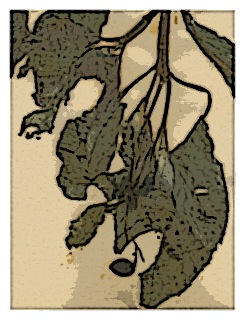
Habit—Erect to scandent shrubs one half to two and a half meters tall. Young growth densely hispidulous to tomentose with suberect, whitish hairs often becoming tan or ferrugineous with age or drying; branchlets subterete, 2 to 4 mm thick, green or reddish; older branches 5 to 10 mm thick, loosely hirtellous, with smooth, purple tan bark.
Leaves—Opposite or rarely temate, membranous, elliptic-ovate, rounded to acute at the base, acuminate and often curved at the apex, 6 to 15 (to 17) cm long, 3 to 6 (to 7) cm wide, matte dark green and hispidulous-strigose above, slightly paler to flushed purple and hispidulous below, especially along the nerves; secondary veins 9 to 14 on either side of the midvein, subelevated below; margin serrulate to denticulate. Petioles pubescent, 2 to 5 (to 7) cm long. Stipules lance-linear, acuminate, dark, 2 to 3 mm long, 0.2 to 0.4 mm wide.

Flowers—Few and pendant in short, corymbiform, terminal racemes, rachis 1.5 to 5 cm long with bracts 10 to 25 mm long. Pedicels slender, pubescent, 15 to 40 mm long, lengthening considerably from bud to fruit, ovary ellipsoid-oblong, 5 to 8 mm long, 2 to 3 mm wide, densely pubescent, floral tube narrowly funnelform, (22 to) 25 to 48 mm long, 2 to 3 mm wide and slightly nodose at the base, constricted to 1.5 to 2 mm wide above the nectary, gradually widened above until 6 to 9 mm wide at the rim, hispidulous outside, villous inside for most its length, sepals lanceolate, 10 to 18 mm long, 3 to 5 mm wide, mostly long acuminate with free tips in bud for 1 to 3 mm, spreading at anthesis. Tube dull pink to lavender or orange red, sepals light red but becoming. pale white toward the tips, petals bright pink red to dark red, elliptic-ovate, mostly about half as long as the sepals, 6 to 10 mm long, 3 to 5 mm wide, acute at the apex, suberect at anthesis. Nectary unlobed or shallowly 4-lobed, about 1.5 mm high. Filaments lavender, 7 to 8 mm and 4 to 5 mm long, anthers oblong, 2 to 3 mm long, 1 to 1.5 mm wide, style villous from the base to near the rim of the tube, stigma capitate, 4-cleft at the apex, 2 to 3mm long, 2 to 3 mm wide, white.
Fruit—The berry is ovoid-ellipsoid, becoming subglobose when fully ripe, 12 to 16 mm long, 6 to 12 mm thick, and pubescent.
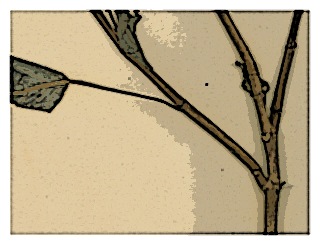
Seeds—About 1.5 mm long, and about 1 mm wide.
Chromosomes—Gametic chromosome number is unknown.
Authors: Johnston 1925.
Original publication—Contr. Gray Herb. 75: 39 1925.
Synonyms—None.
Herbarium Specimens—Edinburgh; Kew; MIssouri; New York; Smithsonian.
F. gehrigeri Munz
Venezuela and Colombia. In cloud forest thickets and woods in the Venezuelan Andes and the Serrania de Perija along the Colombian-Venezuelan border, in Trujillo, Mérida, and Táchira in the Mérida Andes, and in the Sierra de Perija in Zulia, Venezuela and Cesar, Colombia all at elevations from 2,200 to 2,800 (to 3,100) meters.
Natural hybridization with F. venusta and F. nigricans is known to occur.
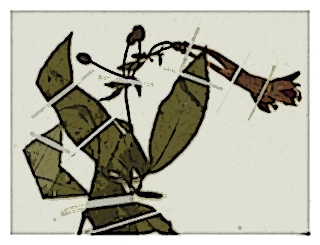
Habit—Erect to usually scandent-climbing shrubs two to five meters high, with arching-pendant branches. Young growth sparsely puberulent to subcanescent, rarely densely pilose; branchlets subterete, subglabrous to strigose (rarely reddish pilose); older stems 8 to 18 mm thick, long and flexuous if climbing, with tan, flaky bark.
Leaves—mostly ternate, occasionally opposite or quaternate, membranous, (narrowly) elliptic to slightly (ob to) ovate, acute to obtuse or attenuate at the base, acute to subacuminate at the apex, 3.5 to 12 cm long, 1.5 to 5 cm wide, deep matte velvety green and strigillose to subglabrous above, pale dull green to purplish and strigillose below, hairs denser along the veins; secondary veins 5 to 12 on either side of the midvein; margin usually denticulate. Petioles light red, 10 to 40 (to 48) mm long. Stipules lanceolate, 1.5 to 2 mm long, divergent-spreading with age, subpersistent.
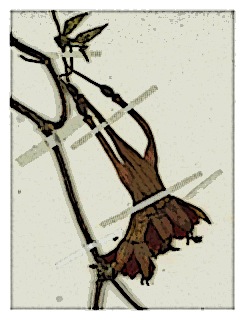
Flowers—Axillary and clustered at the branch tips or sometimes corymbose with a rachis 2 to 6 cm long, flowers, pedicels, and flowering branches pendant, pedicels loosely strigose, 12 to 40 mm long, ovary ovoid, 5 to 7 mm long, 2 to 4 mm thick, strigillose to pilose, floral tube narrowly funnelform, 40 to 50 (to 55) mm long, (2.5)3 to 4 mm wide and bulbous at the base, narrowed to 2 to 3 mm for the basal 18 to 22 mm of the tube, then gradually or usually abruptly widened and 8 to 9 mm wide near the rim, subglabrous to puberulent-strigose outside (rarely pilose), (densely) pilose or villous inside in lower 2 to 4 cm, sepals lanceolate, acute to acuminate at the apex, (13 to) 15 to 21 mm long, (4 to) 5 to 6 mm wide, spreading at anthesis. Tube and sepals subnitid red, petals scarlet, oblong to elliptic-obovate or lanceolate, 14 to 21 mm long, (4 to) 6 to 8 mm wide, obtuse to acute at the apex, margin and surface smooth, often with several hairs on .dorsal surface, spreading to slightly recurved at anthesis. Nectary unlobed or slightly 4-lobed, 1.5 to 2 mm high, filaments light red, sometimes whitish at the base, 10 to 14 mm and 8 to 12 mm long, anthers oblong, 2.5 to 3 mm long, about 1.5 mm wide, white, style red, glabrous to loosely villous, stigma subglobose, 2 to 2.5 mm long, about 2 mm wide, slightly 4-cleft at the apex, dull cream to pink red.
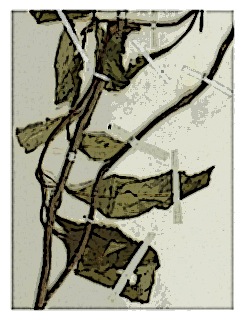
Fruit—The berry is ovoid to subglobose, somewhat quadrangular before maturity, 13 to 16 mm long, 10 to 13 mm thick, and dark red purple at maturity.
Seeds—2 to 3 mm long, 1.1 to 1.4 mm wide.
Chromosomes—Gametic chromosome number n = 11.
Authors—Munz 1943.
Original publication—Proc. Calif. Acad. Sci. IV, 25: 41 1943.
Synonym—F. jahnii Berry 1982.
Herbarium Specimens—Missouri; New York; Smithsonian 1, Smithsonian 2.
F. glaberrima I.M.Johnst.
Ecuador & Peru. Scarce shrub of the lower cloud forest limit from Tungurahua, Ecuador, to Amazonas, Peru, at elevations from 1,600 to 1,900 meters.
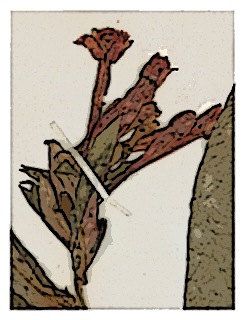
Habit—Simple to few-branched shrubs one to three meters tall. Branchlets subterete, 3 to 5 mm thick, glabrous or minutely and sparsely puberulent on youngest growth, green to redpurple.
Leaves—Opposite or subopposite near the branch tips, firmly membranous to subcoriaceous, oblanceolate, obtuse to attenuate at the base, acute to acuminate at the apex, 10 to 24 cm long, 4 to 8 cm wide, subnitid and glabrous above, pale to usually flushed red-violet below and glabrous to finely puberulent along the nerves; secondary veins 8 to 20 (to 26) on either side of the midvein; margin entire. Petioles short, stout, 3 to 8 mm
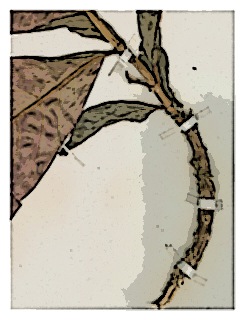
Flowers—3-ca. 15in terminal, bracteate, drooping racemes, rachis 2 to 4 cm long or occasionally extending 6 to 12 cm long in fruit, bracts sessile, lanceolate, 10 to 30 mm long, subtending the alternately disposed flowers, pedicels 3 to 12 mm long, mostly glabrous, ovary oblong, 7 to 9 mm long, 2 to 3 mm thick, floral tube narrowly funnelform, 22 to 35 (to 40) mm long, about 2 mm wide at the base, slightly constricted above the nectary, then gradually widened above until 6 to 7 mm wide at the rim, glabrous outside, densely pubescent inside for most of length, sepals oblong-lanceolate, 8 to 11 mm long, 4 to 5 mm wide, shortly acute-tipped, subtetragonous in bud, spreading at anthesis. Tube and sepals red to orange red, petals red, broadly elliptic-obovate, 7 to 11 mm long, 5 to 6 mm wide, rounded at the apex. Nectary unlobed, about 1.5 mm high, filaments red, 5 to 6 mm and 3 to 4 mm long, anthers oblong, about 2 mm long, about 1 mm wide, style densely pilose or occasionally glabrous, stigma capitate, subtetragonous, about 2 mm long, about 3 mm wide, 4lobed apically, shortly exserted beyond the anthers.
Fruit—The berry is oblong, about 15 mm long, and 7 to 9 mm thick.

Seeds—About 2 mm long, and about 1 mm wide.
Chromosomes—Gametic chromosome number is unknown.
Authors—Johnston 1925.
Original publication—Contr. Gray Herb. 75: 32 1925.
Synonyms—None.
Herbarium Specimens—Field Museum; New York; Smithsonian.
F. harlingii Munz
Southern Ecuador. Rare in cloud forest of Loja and Azuay Provinces at elevations from 2,600 to 3,300 meters.
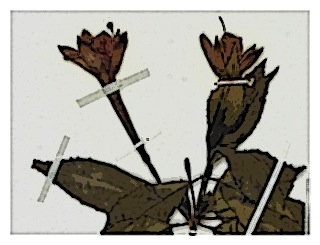
Habit—Erect to scandent shrubs one to three meters tall. Branchlets subterete, 2 to 4 mm thick, glabrous or rarely strigose-villous; older branches with lustrous, purple brown bark, exfoliating in wide strips with age.
Leaves—Opposite or ternate, firmly membranous to subcoriaceous, narrowly elliptic to elliptic-ovate, acute to rounded at the base, acute to acuminate at the apex, 3 to 7 mm long, 1.5 to 2.5 cm wide, glabrous and subnitid dark green above, pale green and glabrous to strigose-villous below; secondary veins 4 to 6 (to 7) on either side of the midvein, sometimes reddish below; margin glandular-serrulate. Petioles 3 to 6 (to 10) mm long. Stipules lance-deltoid, thick at the base, sometimes connate or recurved, 1 to 2 mm long, about 1.5 mm wide, subpersistent.
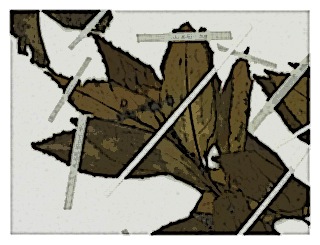
Flowers—Few, pendant, and solitary in the upper leafaxils, pedicels stout, 1 to 2 mm thick, 10 to 15 mm long, ovary tetragonous, 6 to 7 mm long, 3 to 6 mm thick, floral tube cylindric to narrowly funnelform, the base much wider than the ovary, (35 to) 44 to 53 mm long, very firm, 2 to 3 mm thick when fresh, (3 to) 4 to 9 mm wide at the base, 7 to 12 mm wide at the rim, gradually widened from the base to the rim or more often with subparallel sides, glabrous to villous outside, villous inside in lower, sepals lance-oblong, 13 to 17 (to 21) mm long, 5 to 8 mm wide, 2 to 2.5 mm thick when fresh, spreading at anthesis, the tip blunt or less often acute in bud. Tube and sepals pale red to orange, petals red, darker than" the sepals, broadly elliptic-ovate, obtuse at the apex, 10 to 15 mm long, 7 to 11 mm wide, suberect at anthesis. Nectary shallowly four to eight-lobed, 1 to 2 mm high, filaments red, 11 to 14 mm and 7 to 10 mm long, anthers oblong, 3 to 5 mm long, about 2 mm wide, cream, style densely villous from the base to near the rim of the tube, stigma capitate, four-cleft apically, 3 to 5 mm long, 3 to 5 mm wide, red.

Fruit: Unknown.
Seeds—Unknown.
Chromosomes—Gametic chromosome number is unknown.
Authors—Munz 1972.
Original publication—Aliso 7: 409 1972.
Synonym—F. fosbergii Munz 1972.
Herbarium Specimens—Smithsonian.
F. hartwegii Benth.
Colombia. Most common in the Cordillera Central from southern Valle to Putumayo, as a scandent or hedgerow shrub, in cloud forest at elevations between 2,350 and 2,750 meters, present farther north in the Cordillera Central around 3,000 meters in Caldas, Tolima, and southern Antioquia, and with a few collections known from the Cordillera Oriental in Huila and Cundinamarca at elevations from 2,100 to 2,300 meters.

Habit—Low shrubs or small trees one half to four meters tall or scandent-climbing in thickets or trees to 8 meters above the ground. Young growth usually canescent; branchlets 2 to 4 mm thick, subterete, reddish, hirtellous to strigose; older branches erect or arching-flexuous on scandent bushes, 0.5 to 3 meters long, 8 to 50 mm thick, with tan gray, flaking bark.
Leaves—Mostly quaternate, occasionally up to seven per whorl, firmly membranous, narrowly to rather broadly elliptic or oblanceolate, acute to attenuate at the base, acute to acuminate at the apex, 3 to 15.5 cm long, 1.5 to 5.5 cm wide, subnitid dark green and strigose to subglabrous above, pale green and hirtellous to strigose below, especially along the veins; secondary veins 8 to 14 on either side of the midvein, impressed above, prominent and reddish below; margin glandular-denticulate. Petioles hirtellous to strigose, 5 to 32 mm long. Stipules lanceolate, thick at the base, filiform at the tip, 1 to 2 mm long, about 0.6 mm wide,deciduous.
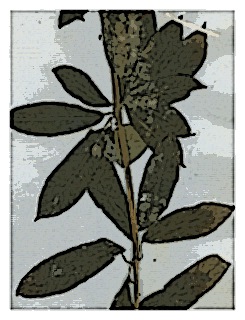
Flowers—Hermaphroditic or gynodioecious, numerous, fasciculate, racemose, or more commonly paniculate at the branch tips, rachis 5 to 20 cm long, bracts broadly ovate, sometimes sessile, 6 to 20 mm long, 3 to 15 mm wide, pedicels slender, arching to pendant, pubescent, 4 to 12 mm long, ovary ellipsoid, strigose to pilose, 3.5 to 5 mm long, 1.5 to 2 mm thick, floral tube narrowly funnelform, 13 to 2 0 (to 24) mm long, 1.5 to 3 mm wide and bulbous at the base, constricted to 1 to 2 mm wide above the nectary and gradually widened above until 2 to 5 mm wide at the rim, strigose to pilose outside, densely villous inside in the lower half, sepals
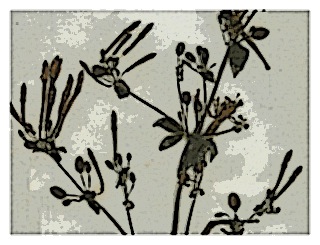
Fruit—The berry is globose when ripe, 6 to 9 mm long, 5 to 8 mm thick, and nitid purple red.
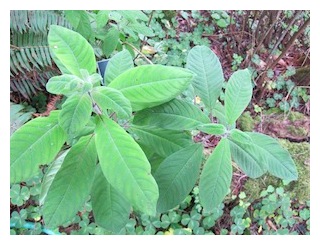
Seeds—Tan to reddish brown, 1.1 to 1.3 mm long, and about 0.7 mm wide.
Chromosomes—Gametic chromosome number n = 11.
Authors—Bentham 1845.
Original publication—Pl. Hartw. 179 1845.
Synonyms—None.
Herbarium Specimens—Edinburgh; Kew 1, Kew 2.
F. hirtella Kunth
Colombia. In the Cordillera Oriental in Cundinamarca, mostly on the outer slopes of the Sabana de Bogotá, in the Cordillera Central from Caldas to Valle, and growing in moist cloud forest clearings or thickets all at elevations between 2,500 and 3,300 meters.
Habit—Climbing-scandent to suberect shrubs two to five meters tall. Branchlets subterete, 2 to 4 mm thick, green to reddish and densely hirtellous; older branches 10 to 25 mm thick, with freely exfoliating bark.
Leaves—Mostly quaternate, occasionally in whorls of 3 or 5, membranous, elliptic to narrowly elliptic or obovate, acute to truncate at the base, acute at the apex, 6 to 13 cm long, 1.8 to 5 cm wide, subnitid dark green and loosely strigose above, pale green and densely strigose below; secondary veins 10 to 15 on either side of the midvein, prominent below; margin entire to subdenticulate. Petioles strigose, reddish, 3 to 8 (to 15) mm long. Stipules lance-linear, hirtellous, 1.5 to 2 mm long, about 0.5 mm wide, deciduous.
Flowers: Inflorescence an arching to .pendant panicle at the tips of branches, flowers numerous, subtended by reduced, sometimes reflexed leaves, rachis hirtellous, 4 to 20 cm long, pedicels slender, pubescent, 4 to 12 mm long, ovary cylindric, 5 to 7 mm long, about 2 mm thick, floral tube subcylindric, ~~4 to 40 mm long, 3 to 4 mm wide and bulbous at the base, narrowed to 2 to 3 mm wide in the basal ~, then gradually widened above until 5 to 9 nun wide at the rim, strigillose to pilose outside, densely villous inside in basal, sepals lanceolate, acuminate, 12 to 16 mm long, 3 to 4 mm wide, long-tapered to apiculate in bud, spreading to divergent at anthesis. Tube and sepals subnitid lavender to reddish pink, petals somewhat darker, crimson, narrowly elliptic-oblong, sharply acute at the apex, 12 to 16 mm long, 3 to 4 mm wide, spreading at anthesis. Nectary unlobed, light green, about 1.5 mm high and about 1 mm thick, filaments pink, 8 to 14 mm and 5 to 10 mm long, anthers oblong, 2.5 to 3 mm long, 1.5 to 2 mm wide, dull white, style slender, glabrous, pink, stigma
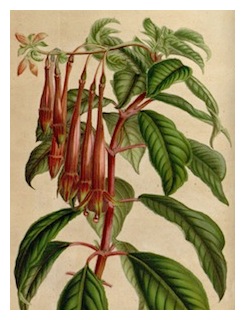
Fruit—The berry is cylindric-ellipsoid, 14 to 18 mm long, and 8 to 9 mm thick.
Seeds—1.4 to 1.7 mm long, and about 0.7 mm wide.
Chromosomes—Gametic chromosome number n = 11.
Authors—Humboldt, Bonpland & Kunth 1823.
Original publication—Nov. Gen. Sp. 6: 107 1823.
Synonyms—None.
Herbarium Specimens—None on line.
Botanical illustration—Houtte, L. van, Flore des serres et des jardin de l’Europe, vol. 8: t. 754 (1853).
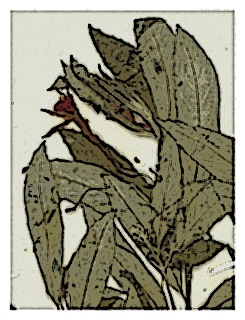
Southern Ecuador. In moist thickets, stream sides, and road banks on the eastern slopes of Prov. Zamora-Chinchipe and Morona-Santiago at elevations from 1,600 to 2,250 meters.
This is a scandent to erect shrub 1 to 3 meters tall, mostly with numerous short lateral branches 50 to 120 mm long near the tips of the main stems. [Type description coming.]
Authors—Johnston 1925.
Original publication—Contr. Gray Herb. 75: 34 1925.
Synonyms—F. loxensis, Berry 1982.
Herbarium Specimens—Smithsonian.


F. lehmannii Munz
Southern Ecuador. Moist thickets, stream sides, and road banks on the eastern slopes of Prov. Zamora-Chinchipe and Morona-Santiago at elevations from 1,600-2,250 meters.
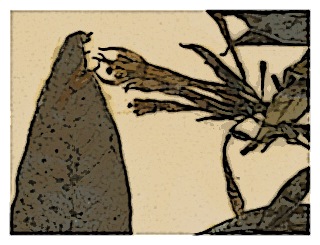
Habit—Scandent to erect shrubs one to three meters tall, mostly with numerous short lateral branches 5 to 12 cm long near the tips of the main stems.
Leaves—2 to 4 per node, mostly ternate or quaternate, membranous, narrowly (ob to) lanceolate to narrowly elliptic, acute to acuminate at the base, acuminate at the apex, 4 to 11 (to 15) cm long, 1 to 3.5 (to 4.2) cm wide, subnitid dark green and glabrous above, pale green and glabrous or pubescent along veins below; secondary veins 8 to 10 (to 11) on either side of the midvein, impressed above, margin entire. Petioles 4 to 12 (to 20) mm long, subglabrous to strigillose, mostly reddish. Stipules lanceolate, 1.5 to 2 mm long, 0.4 to 0.8 mm wide, deciduous.
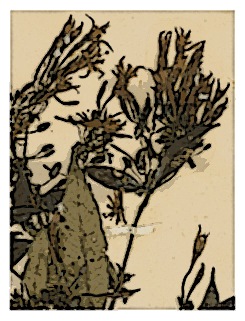
Fruit—The berry is oblong-ellipsoid, 11 to 15 mm long, 7 to 8 mm thick, and turning dark purple at maturity.
Seeds—0.9 to 1.1 mm long, and 0.7 to 0.8 mm wide, brown.
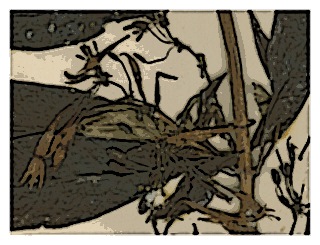
Chromosomes—Gametic chromosome number n = 11.
Authors—Munz 1943.
Original publication—Proc. Calif. Acad. Sci. IV, 25: 61 1943.
Synonyms—None.
Herbarium Specimens—Field Museum 1, Field Museum 2; Kew; Smithsonian.
(Illustration—For image see ➤ F. lehmannii, Field Museum, Neotropical Live Plant Photos, Photo ID 11656.)
F. llewelynii Macbr.
Northern Peru. Known from the mountains near La Ventana and Almirante, east of Chachapoyas and in the Serrania de Bagua, Amazonas Department, at elevations from 2,600 to 3,300 meters.
Habit—Low shrubs with puberulent or canescent branchlets with spinescent projections, usually appearing papillose or verrucose when dry.
Leaves—Opposite or ternate, membranous to subcoriaceous, narrowly oblong to elliptic or oblanceolate, acute at both ends, 2.5 to 9 (to 20) cm long, 1.2 to 4 cm wide, glabrous to strigillose on both surfaces; secondary veins 9 to 13 (to 25) on either side of the midvein; margin conspicuously dentate or serrulate. Petioles 3 to 9 mm long. Stipules narrowly lanceolate or filiform, 2 to 5 mm long, subpersistent.
Flowers—Few and axillary at the branch tips or subracemose, pedicels slender, puberulent, verrucose or with spinescent protuberances, 2 to 6 cm long, ovary narrowly oblong, 5 to 6 mm long, about 1.5 mm thick, floral tube cylindric-funnelform, (40 to) 45 to 54 mm long, slightly bulbous and 3 to 4 mm wide at the base, narrowed briefly to 2 to 3 mm wide above the nectary, then widened above until 5 to 8 mm wide at the rim, subglabrous to puberulent outside, pilose inside in lower %, sepals narrowly lanceolate, acuminate, 13 to 17 mm long, 4 to 8 mm wide, with a tip about 2 mm long in bud. Tube and sepals dull pink, petals pink, narrowly lanceolate to elliptic, acute to acuminate, 15 to 20 mm long, 4 to 8 mm wide. Nectary unlobed, about 2 mm high, filaments 12 to 13 mm and 10 to 11 mm long, anthers oblong, 2.5 to 3 mm long, 1 to 1.5 mm wide, style densely pilose for most its length, stigma subobconic, about 2 mm long, 1.5 to 2 mm wide.
Fruit—The berry is ellipsoid, 12 to 15 mm long, and about 8 mm thick.
Seeds—Unknown.
Chromosomes—Gametic chromosome number is unknown.
Authors—Macbride 1941.
Original publication—Publ. Field Mus. Nat. Hist., Bot. Ser. 13(4): 556 1941.
Synonyms—None.
Herbarium Specimens— None on line.
F. loxensis Kunth
Ecuadorian Andes. Locally common in hedgerows along fields and in thickets, mainly in the moderately dry inter-Andean valleys of Ecuador, also on the moister eastern and western slopes, from Loja to Pichincha, with a few scattered collections farther north in Imbabura and Carchi at elevations from (2,000 to) 2,500 to 3,500 (to 3,800) meters.

Habit—Low shrubs with puberulent or canescent branchlets with spinescent projections, usually appearing papillose or verrucose when dry.
Leaves—Opposite or ternate, membranous to subcoriaceous, narrowly oblong to elliptic or oblanceolate, acute at both ends, 2.5 to 9 (to 20) cm long, 1.2 to 4 cm wide, glabrous to strigillose on both surfaces; secondary veins 9 to 13 (to 25) on either side of the midvein; margin conspicuously dentate or serrulate. Petioles 3 to 9 mm long. Stipules narrowly lanceolate or filiform, 2 to 5 mm long, subpersistent.

Flowers—Few and axillary at the branch tips or subracemose, pedicels slender, puberulent, verrucose or with spinescent protuberances, 2 to 6 cm long, ovary narrowly oblong, 5 to 6 mm long, about 1.5 mm thick, floral tube

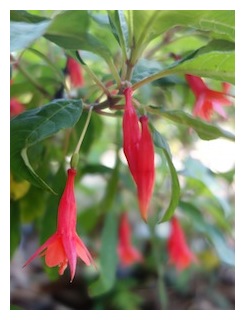
Fruit—The berry is ellipsoid, 12 to 15 mm long, and about 8 mm thick.
Seeds—Unknown.
Chromosomes—Gametic chromosome number is unknown.
Authors—Humboldt, Bonpland & Kunth 1823.
Original publication—Nov. Gen. Sp. 6: 106 1823.
Synonyms—F. umbrosa, Bentham 1845; F. apiculata, Johnston 1925; F. hypoleuca, Johnston 1925.
Herbarium Specimens—Berlin; Field Museum; Kew; New York 1, New York 2; Smithsonian.
F. macropetala C.Presl
Central Peru. Known only from the Cordillera Azul, which is a semi-isolated Andean spur to the east of the main Andean cordilleras of Peru and which runs along the Huánuco-Loreto border before joining the main cordillera in southern Huánuco In clearings and roadsides at elevations from 1,600 to 1,800 meters.
Habit—Erect to scandent shrubs one and a half to three meters tall. Young growth minutely puberulent; older branches glabrescent, with finely-splitting, tan brown bark.
Leaves—Opposite, firmly membranous, elliptic, mostly acute at the base, acute to shortly acuminate at the apex, (7 to) 9 to 18 cm long, (3 to) 4 to 8 cm wide, subglabrous to strigillose on both surfaces, sometimes purple flushed below; secondary veins 13 to 18 on either side of the midvein, often reddish, prominent below and anastomosing into a submarginal vein; margin subentire. Petiole subglabrous, 6 to 16 mm long. Stipules lanceolate to triangular, sometimes connate, 1 to 2 mm long, about 0.7 mm wide, mostly deciduous.
Flowers—Few to many in lateral racemes or on short side branchlets 1 to 6 (to 10) cm long, pedicels subglabrous, 9 to 26 mm long, reddish, ovary ellipsoid, 6 to 8 mm long, about 3 mm thick, light green, finely strigillose and more-or-less verrucose, floral tube subcylindric, 32 to 45 mm long, 2.5 to 3 mm wide at the base, slightly constricted to about 2 mm wide above the nectary and gradually widened above until 5 to 7 mm wide at the rim, finely strigillose outside, pilose inside in Iower vs, sepals lanceolate, 10 to 13 mm long, 3 to 5 mm wide, spreading at anthesis. Tube and sepals bright red, petals red, elliptic-oblong, 10 to 12 mm long, 4 to 6 mm wide. Nectary mostly unlobed, 1 to 1.5 mm high, filaments red, 7 to 10 mm and 5 to 8 mm long, anthers oblong, about 2 mm long, about 1 mm wide, style pubescent for most its length, red, stigma capitate, about 2 mm long, 2 to 4 mm wide, slightly 4-cleft apically, dull white to pink, exserted 4 to 10 mm beyond the anthers.
Fruit—The berry is ellipsoid, 15 to 18 mm long, 7 to 10 mm thick, and dull dark purple.
Seeds—1.5 to 2 mm long, 0.9 to 1.2 mm wide, and dark purple.
Chromosomes—Gametic chromosome number is unknown.
Authors—Presl 1831.
Original publication—Reliq. Haenk. 2: 28 1831.
Synonyms—None.
Herbarium Specimens— None on line.
F. macrophylla I.M.Johnst.
Central to southern Peru, from Loreto and Huánuco to Puno. In moist thickets in low elevation cloud forest and subtropical wet forest at elevations from 1,200 to 2,000 meters.

Habit: Erect to scandent shrubs on to three meters tall with spreading branches. Young growth minutely puberulent, branchlets 3-6 mm thick, usually red-purple tinged; older branches with light brown, finely fissured bark.
Leaves: Opposite or less often ternate, firmly membranous, (narrowly) elliptic to lanceolate or (obovate, acute to cuneate at the base, acute to acuminate at the apex, basal leaves generally considerably larger than the upper ones, 16 to 27 cm long, 5 to 9 cm wide, light to dark green and subglabrous above, paler and subglabrous below; secondary veins 14 to 19 on either side of the midvein, reddish and prominent below, anastomosing into a distinct submarginal vein; margin subentire. Petioles subglabrous, 10 to 35 mm long, reddish. Stipules dark, lanceolate to triangular, sometimes connate, 1 to 2 mm long, 0.5 to 0.8 mm wide, mostly deciduous.
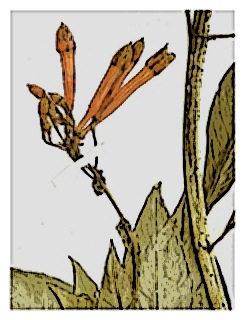
Flowers: Few to numerous in short lateral racemes or on short sidebranchlets, rachis 2 to 10 (to 12) cm long, pedicels slender, spreading, 10 to 26 (to 32) mm long, reddish, ovary ellipsoid, 4 to 5 mm long, about 2 mm thick, floral tube, narrowly funnelform, 19 to 25 mm long, about. 2 mm wide and slightly nodose at the base, gradually widened above until 4 to 6 mm wide at the rim, puberulent to subglabrous outside, pilose inside for most of length, sepals lance-oblong, acute, 8 to 9 mm long, 3 to 4 mm wide, short-pointed in bud. Tube red, sepals red with green tips, petals scarlet, elliptic to lanceolate, acute, 7 to 10 mm long, 3 to 4 mm wide. Nectary unlobed, about 1 mm high, filaments red, 4 to 7 mm and 3 to 4 mm long, anthers oblong, 1.4 to 1.6 mm long, about 0.8 mm wide, dull white, style pubescent for most of length, red, stigma capitate, about 2 mm long and wide, shallowly four-lobed, cream to pink, exserted 1 to 2 mm beyond anthers.
Fruit: Berry subglobose to ellipsoid, 10 to 13 mm long, 8 to 9 mm thick, and nitid dark purple;
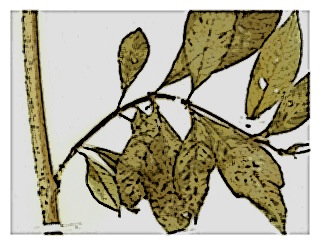
Seeds: Tan, 1.1 to 1.3 mm long, and about 0.7 mm wide.
Chromosomes: Gametic chromosome number n = 11.
Authors: Johnston 1925.
Original publication—Contr. Gray Herb. 75: 35 1925.
Synonyms—None.
Herbarium Specimens—Field Museum; Smithsonian
F. macrostigma Benth.
Cordillera Occidental of Colombia and Ecuador. Infrequent in moist cloud forest thickets on Pacific slopes at elevations from 1,000 to 2,500 meters.
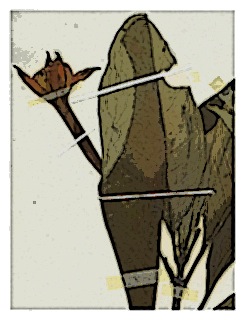
Habit: Erect shrubs one half to one and a half meters tall. Branchlets stout, sub succulent, 2 to 7 mm thick, terete or angled, green. to dull purple; older branches 8 to 15 mm thick, dull tan, with finely fissured bark.
Leaves: Leaves opposite or less often ternate, firmly membranous, narrowly to broadly elliptic ~9 (ob-)ovate, acute at the base, acute to acuminate at the apex, 6 to 27 cm long, 3 to 12 cm wide, velvety dark green and subglabrous to puberulent above, pale green to wine purple below with strigose to villous pubescence mostly along the veins; secondary veins 9 to 15 (to 22) on either side of the midvein; margin remotely denticulate with small, glandular teeth. Petioles stout, 2 to 3 mm thick, 15 to 30 (to 35) mm long, strigose, green to purple. Stipules dark, triangular, sometimes connate, 2 to 2.5 mm long, about 2 mm wide, deciduous.

Flowers: Few and axillary in upper nodes, pedicels stout, 2 to 2.5 mm thick, 8 to 20 (to 30) mm long, pubescent, spreading to ascending, ovary cylindrical, 8 to 12 mm long, 3 to 5 mm thick, green, verrucose, 4 to 8 sulcate, floral tubes narrowly funnelform, 50 to 0 mm long, 2 to 5 mm wide and bulbous at the base, gradually widened above until 4 to 10 mm wide at the rim, subglabrous to villous outside, sparsely pilose inside in lower ~, tube firm-spongy, 1 to1.5 mm thick when fresh, often curved downward in distal ~, sepals lance-oblong, 14 to 23 mm long, 7 to 8 mm wide, thick-spongy, 1 to 2 mm thick when fresh, apiculate, divergent, tips free and spreading in bud. Tube pale to dark red, sepals red with dull green tips, petals bright red, shorter than the sepals, orbicular to broadly obovate, 12 to 18 mm long, 10 to 19mm wide, undulate, rounded at the apex, strongly spreading. Nectary green, unlobed, about 3 mm high and about 1.5 mm thick, filaments red, 8 to 12 mm and 5 to 8 mm long, anthers oblong, 2.5 to 3.5 mm long, about 1.5 mm wide, style pink, sparsely pubescent to subglabrous,

Fruit: The berry is ellipsoid, eight-sulcate until fully ripe, verrucose, 20 to 22 mm long, and 8 to 12 mm thick;
Seeds: Tan brown, 2 to 2.5 mm long, and 1.2 to 1.6 mm wide.
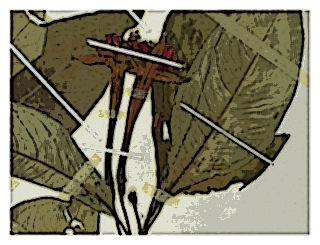
Authors—Bentham 1844.
Original publication—Pl. Hartw. 129 1844.
Synonyms—F. longiflora, Bentham 1845; F. spectabilis, Hooker 1848; F. spectabilis var. pubens, Johnston 1925; F. macrostigma var. longiflora, Bentham 1845 and Munz 1943; F. macrostigma var. typica, Munz 1943; F. macrostigma var. macrostigma 1974.
Herbarium Specimens—Berlin; Field Museum; Kew 1, Kew 2; Smithsonian.
F. magdalenae Munz
Columbia. Endemic to upper cloud forest of the Sierra Nevada de Santa Marta in northeastern Colombia at elevations from (2,000 to) 3,000 to 3,350 meters.
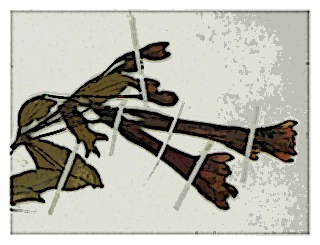
Habit—Shrubs two to five meters tall. Young growth glabrous to lightly strigose; branchlets purplish, older branches red brown, with bark exfoliating in strips.
Leaves—Ternate or less often quaternate, firmly membranous to subcoriaceous, (narrowly) elliptic to ovate, acute to rounded at the base, acute to subacuminate at the apex, 2.5 to 8.5 (to 12) cm long, 1 to 4 (to 6) cm wide, dark green and mostly glabrous above, pale green with purplish veins and glabrous below, except for hairs usually present along the margin; secondary veins 8 to 14 one either side of the midvein; margin denticulate or subentire. Petioles purplish, sparsely strigose, 4 to 25 (to 30) mm long. Stipules lanceolate to triangular, dark, about 1 mm long, deciduous.

Flowers—pendant and solitary in upper leafaxils, pedicels firm, 15 to 60 mm long, mostly red, ovary ovoid-ellipsoid, glabrous, 7 to 10 (to 11) mm long, 3 to 3.5 mm thick, floral tube subcylindric, (35 to) 42 to 60 mm long, firm-fleshy, about 1 mm thick when fresh, 3.5 to 6 mm wide at the base, sometimes slightly narrowed above the nectary, very gradually widened above until 6 to 10 mm wide at the rim, glabrous inside and outside, sepals lanceolate, acute to subacuminate, 13 to 18 (to 22) mm long, 4 to 5 (to 6) mm wide, blunt-tipped in bud, spreading at anthesis. Tube slightly purplish at the base and orange red above, sepals nitid orange red with greenish tips, petals orange red, suborbicular to obovate or subrhomboid, sometimes with irregular margins, 11 to 19 mm long, 7 to 12 (to 18) mm wide, usually with a narrowly acute tip. Nectary an uneven band of lustrous tissue lining the basal 3 to 6 mm of the floral tube, without prominent lobes, filaments light red, 12 to 16 mm and 8 to 13 mm long, anthers oblong, 3.5 to 4 mm long, about 2.5 mm wide, cream, style light red to orange, glabrous, stigma capitate, lightly 4-cleft apically, 2 to 3 mm long, 2 to 4 mm wide.Tight red to orange, exserted ~10 mm beyond the anthers,
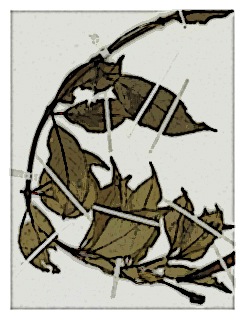
Fruit—The berry is ellipsoid, 20 to 24 mm long, 10 to 12 mm thick, and usually dark purple.
Seeds—(1.5 to) 2 to 2.5 mm long, and 1 to 1.3 mm wide.
Chromosomes—Gametic chromosome number is unknown.
Authors—Munz 1943.
Original publication—Proc. Calif. Acad. Sci. IV, 25: 41 1943.
Synonyms—F. lampadaria, Wright 1979.
Herbarium Specimens—Smithsonian.
F. mathewsii J.F.Macbr.
Northern Peru. Scattered to locally frequent in cloud forest along stream sides or in semi-disturbed sites such as road banks or thickets, or in somewhat drier, shrubby woodlands in Cajamarca and Amazonas Departments at elevations from (2,500 to) 2,700 to 3,350 meters.

Habit—Suberect shrubs one to three meters tall, puberulent to mostly densely pilose with white to generally rusty hairs. Branchlets triangular (when leaves are ternate) or rarely subtetragonous, dull purple to ferrugineous-pilose; older branches 7 to 14 mm thick, with pilose, reddish bark exfoliating in strips.
Leaves—mostly ternate, occasionally quaternate, firmly membranous, narrowly elliptic to oblanceolate or elliptic, at times slightly asymmetrical and curved to one side, narrowly obtuse at the base, acute at the apex, 4 to 16 cm long, 1.2 to 5 cm wide, dull to subnitid dark green and pilose to strigose above, lighter green and mostly rusty-pilose below, with hairs denser along the nerves, blades sometimes purple flushed; secondary veins 8 to 12 on either side of the midvein; margin subdenticulate. Petioles pubescent to densely ferrugineous-pilose, 3 to 10 (to 25) mm long. Stipules narrowly lanceolate when young, becoming thick and triangular with age, dark, 2 to 3 mm long, about 1 mm wide, subpersistent.
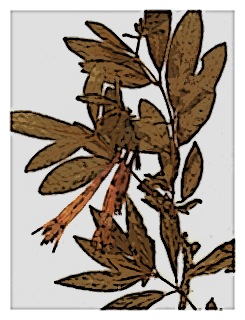
Flowers—Numerous and crowded at the tips of terminal, arching-drooping racemes or few-branched panicles, rachis 3 to 6 cm long, bracts lacking or rapidly deciduous, 10 to 25 mm long, about 6 mm wide, pedicels pubescent to pilose, 12 to 25 mm long, ovary ellipsoid, 5 to 7 mm long, 2 to 3.5 mm thick, green to purple, floral tube narrowly funnelform, (32 to) 36 to 63 mm long, 2.5 to 3.5 mm wide and slightly bulbous at the base, narrowed to about 2 mm wide above the nectary, then widened gradually above until 5 to 8 mm wide at the rim, mostly pilose outside, pilose to villous inside in lower ~, sepals lanceolate, blunt tipped and broader than the tube in bud, 11 to 16 mm long, 4 to 5 mm wide, lobes often splitting open in the middle before detaching at the tips, suberect to spreading at anthesis. Tube and sepals pale pink to lavender or light red, petals slightly darker than the tube or sepals, crimson to light purple, lanceolate to narrowly elliptic, 10 to 16 mm long, 3 to 4 mm wide, obtuse to subacuminate at the apex, spreading at anthesis. Nectary unlobed, about 1.5 mm high, filaments dull white to light red, 7 to 9 mm and 4 to 6 mm long, anthers oblong, 2 to 2.5 mm long, about 1.5mm wide, white, style pink, villous from the base to the rim of the tube, stigma subglobose, 4-cleft at the apex, 2.5 to 3.5 mm long, 2 to 3 mm wide, pink.

Fruit—The berry is subglobose to ellipsoid, 10 to 16 (to 20) mm long, 8 to 11 (to 15) mm thick, and lustrous red purple.
Seeds—1.8 to 2.1 mm long, and about 1 mm wide.
Chromosomes—Gametic chromosome number n = 11.
Authors—Macbride 1940.
Original publication—Candollea 8: 24 1940.
Synonyms—F. fischeri, J. F. Macbride 1941; F. storkii, Munz 1943.
Herbarium Specimens—Field Museum 1, Field Museum 2; Kew.
F. nigricans Linden ex Planch.
Venezuela and Colombia. Scattered to locally frequent in forest openings, stream banks, along roadsides, and in moist thickets in mid elevation cloud forest in Venezuela, from Lara to Tachira at elevations from 2,100 to 2,650 meters, and in Colombia (in all three cordilleras) in the Cordillera Oriental known only from Norte de Santander near the Venezuelan border, in the Cordillera Central in Tolima, Quindio, Caldas, and Antioquia and in the Cordillera Occidental from Antioquia south to Cauca at elevations from 1,700 to 2,700 meters

Natural hybrids with F. gehrigeri, F. putumayensis and F. venusta are known.
Habit—Erect to scandent shrubs one to three meters tall with suberect to spreading branches. Young growth densely canescent with appressed or less often suberect hairs; branchlets terete, 2 to 5 mm thick, dull purple to light green; older branches with light brown, splitting bark.

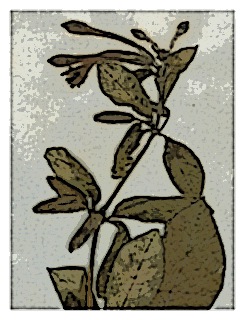
Fruit—The berry is cylindric, 15 to 25 mm long, 6 to 10 mm thick, dull green to flushed purple, strigillose, and slightly verrucose before maturity.
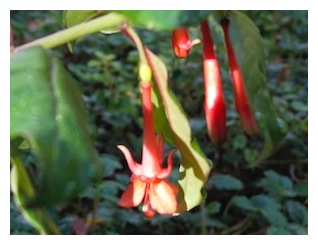
Seeds—Tan, 1.3 to 1.6 mm long, and about 0.8 mm wide.
Chromosomes—Gametic chromosome number n = 11.
Authors—Linden ex Planchon 1849.
Original publication—Fl. Serres Jard. Eur. 5: 481 1849.
Synonyms: F. atrorubra, Johnston 1925; F. adpressibilis, Steyermark 1952.
Herbarium Specimens—Kew 1, Kew 2; New York 1; Smithsonian.
F. orientalis P.E.Berry
Ecuador. Scattered in low elevation cloud forest on the eastern slopes of the Andes from Napo to Zamora-Chinchipe at elevations from 1,200 to 2,600 meters.
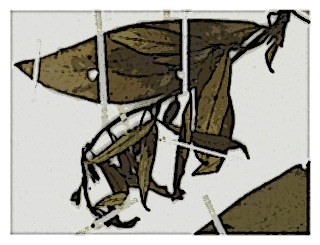
Habit—Shrubs one to two meters tall. Young growth puberulent to strigillose.
Leaves—Opposite, rarely ternate, membranous, narrowly elliptic to obovate, acute to attenuate or unequal at the base, acute to acuminate at the apex, 6 to 21 cm long, 2.5 to 6 cm wide, subnitid and subglabrous to strigillose above, paler and mostly strigillose or puberulent along the veins and margin below; secondary veins 12 to 17 on either side, mostly prominent below, margin entire. Petioles strigillose, 8 to 20 mm long. Stipules lanceolate, 1.5 to 3 mm long, 0.5 to 0.8 mm wide, mostly persistent and becoming thick and recurved on lower nodes.

Flowers—Few to many in abrupt, terminal and axillary, bracteate racemes, rachis 5 to 16 cm long, elongating in fruit, bracts lanceolate, persistent, 10 to 25 mm long, 3 to 10 mm wide, with petioles 3 to 5 mm long, pedicels strigose, 3 to 7 (to 12) mm long, ovary cylindrical, 4 to 5 mm long, 1.5 to 2 mm thick, floral tube narrowly funnelform, 15 to 21 mm long, about 2 mm wide and slightly bulbous at the base, gradually widened above until 3.5 to 5 mm wide at the rim, strigillose outside, retrorse villous in lower Vi, sepals oblong-lanceolate, 6 to 8 mm long, 3 to 4 mm wide. Tube and sepals scarlet to orange red, petals red to orange red, oblong to broadly elliptic, 5 to 8 mm long, 3 to 4 mm wide. Nectary unlobed or shallowly lobed, 1 to 1.5 mm high, filaments red, 6 to 7 mm and 4 to 5 mm long, anthers broadly oblong, about 1.5 mm long and about 1 mm wide, white, style red, mostly glabrous, stigma capitate, 1.5 to 2 mm long, about 2.5 mm wide, 4-cleft at the apex.
Fruit—The berry is cylindrical, verrucose, 9 to 12 mm long, about 5 mm thick, and red purple.
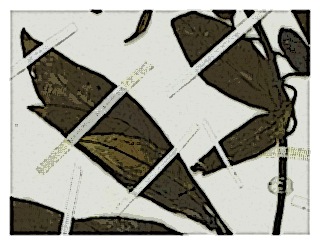
Chromosomes—Gametic chromosome number n = 11.
Authors—Berry 1982.
Original publication—Ann. Missouri Bot. Gard. 69: 79 1982.
Synonyms—None.
Herbarium Specimens—Field Musuem; Kew; Smithsonian.
(Illustration—See ➤ F. orientalis, Field Museum, Neotropical Live Plant Photos, Photo ID 11169.
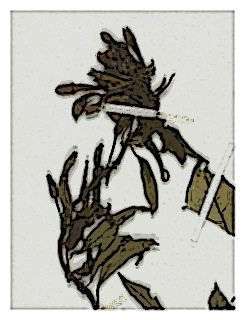
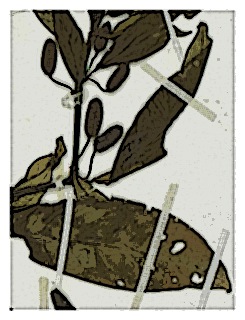
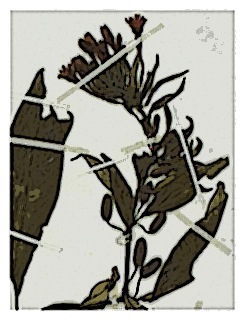
F. ovalis Ruiz & Pav.
Central Peru. Restricted to Huánuco, Pasco, and Junín Departments and rare in cloud forest thickets at elevations from 2,000-2,800 meters.
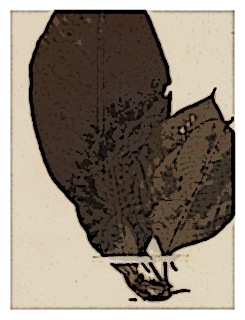
Habit—Erect to scandent shrubs one to three meters tall. Young leaves and shoots mostly densely pilose; older branches pilose to glabrescent, 5 to 13 mm thick, with light tan, finely fissured bark.
Leaves—Opposite to quaternate, firmly membranous, broadly elliptic to ovate, rounded to acute at the base, acute to short acuminate at the apex, mature leaves 8 to 16 cm long, 3 to 7.5 cm wide, dark green and strigose above, paler green and strigose-pilose below, especially along the veins; secondary veins 14 to 17 on either side of the midvein, emerging from the midvein at more-or-less 90° and becoming gradually incurved towards the margin, a
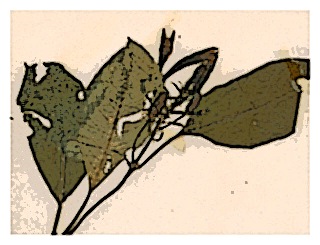
Flowers—Several to numerous in lateral racemes or panicles, rachis 5 to 10 cm long, bracts narrowly lanceolate, long acuminate, pilose, 6 to 12 mm long, pedicels pilose, more-or-less divergent, 10 to 20 mm long, ovary cylindrical, 5 to 7 mm long, about 2 mm thick, loosely pilose, floral tube narrowly funnelform, 18 to 20 mm long, a
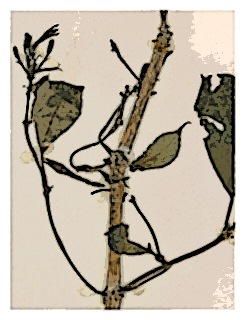
Fruit—The berry is cylindrical or ellipsoid, 12 to 13 mm long, about 6 mm thick, subtetragonous, and red purple.
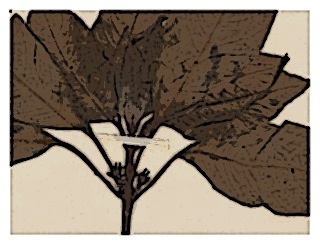
Seeds—0.9 to 1.1 mm long, and about 0.7 mm wide.
Chromosomes—Gametic chromosome number is unknown.
Authors—Ruiz & Pavon 1802.
Original publication—Fl. Peruv. 3: 87 1802.
Synonyms—F. polyanthella, Johnston 1925.
Herbarium Specimens—Missouri; New York.
F. pallescens Diels
Ecuador and southern Colombia. Moist, shady cloud forest habitats, restricted to the eastern slopes of the Andes in Ecuador from Azuay to Napo, and disjunct to the west slopes of the Cordillera Occidental in Cauca, Colombia at elevations from 2,550 to 2,900 meters.
Natural hybridization with in some populations where it is sympatric with F. scabriuscula and F. vulcanica is suspected
Habit—Usually well-branched herbs to subshrubs fifty to one 180 cm tall. Branchlets subterete, semisucculent, 2 to 4 mm thick, subglabrous; older stems ~8 mm thick, with dull tan, finely fissured bark.
Leaves—Opposite or ternate, thin membranous, ellipticovate, attenuate to rounded at the base, subacuminate at the apex, 3.5 to 7 (to 9.5) cm long, 1.5 to 4 (to 5) cm wide, velvety dark green and glabrous to strigillose above, paler below and subglabrous to puberulent, especially along the veins; secondary veins 5 to 7 (to 9) on either side of the midvein, lightly impressed above and subelevated below; margin gland-denticulate. Petioles slender, (15 to) 25 to 40 (to 50) mm long, glabrous to puberulent, green. Stipules triangular, 1 to 1.5 mm long, about 0.5 mm wide, succulent at the base, sometimes connate and reflexed on lower nodes, subpersistent.
Flowers—Few and pendant in upper leaf axils or subracemose at the tips of branches with reduced leaves 10 to 20 mm long subtending the flowers, pedicels slender, drooping, 7 to 15 mm long, ovary narrowly cylindric, 5 to 8 mm long, 2 to 3 mm thick, floral tube narrowly funnelform, 18 to 25 mm long, slightly nodose at the base and 1.5 to 2 mm wide, gradually widened above until 4 to 5 mm wide at the rim, glabrous to puberulent outside, densely pilose inside in lower half, sepals lanceolate, acute to long acuminate, 9 to 15 mm long, 3 to 4 mm wide, spreading at anthesis, Tube and sepals subnitid whitish pink to pale- red, petals considerably darker, maroon to dark red, broadly elliptic, acute to rounded at the apex, 5 to 8 mm long, about 4 mm wide, suberect. Nectary unlobed, 1 to 1.5 mm high, filaments light pink, 5 to 7 mm and 3 to 5 mm long, anthers oblong, 1 to 1.5 mm long, about 0.8 mm wide, cream to pale yellow, style glabrous, light pink, stigma capitate, 4-lobed in upper Vi, 1.5 to 2.5 mm long, 2 to 3 mm wide, white.
Fruit—The berry is oblong, narrowed apically, rugose before maturity, turning lustrous purple, about 13 mm long, and 4 to 6 mm thick.
Seeds—About 1 mm long, 0.6 to 0.7 mm wide.
Chromosomes—Gametic chromosome number n = 11.
Authors—Diels 1938.
Original publication—Notizbl. Bot. Gart. Berlin-Dahlem 14: 34 1938.
Synonyms—None.
Herbarium Specimens—None on line.
F. petiolaris Kunth
Colombia and Venezuela. In thickets of high elevation cloud forest or in páramo shrub islands in the Cordillera Oriental from Huila to Norte de Santander and just into Venezuela in southern Tachira, in the Cordillera Central from northern Valle to Antioquia, and in the Cordillera Occidental in Antioquia, at elevations from (2,400 to) 2,900 to 3,900 meters.
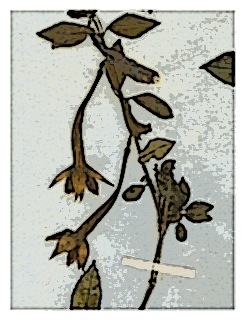
Habit—Low shrubs on half to two meters tall or climbing-scandent in trees to five meters above ground. Young growth puberulent to pilulose; branchlets terete, 1.5 to 3 mm thick, puberulent to ferrugineous-pilose, green to light red purple; older branches 5 to 12 mm thick, with reddish tan, exfoliating bark.
Leaves—mostly ternate, up to six per whorl, firmly membranous to subcoriaceous, narrowly lanceolate to elliptic or obovate, acute to narrowly cuneate at the base, mostly acute at the apex, (1.5 to) 3 to 9 (to 11) cm long, (0.5 to) 1 to 3 (to 4.5) cm wide, medium to dark matte green and glabrous to puberulent above, pale green and subglabrous to puberulent or pilose below; secondary veins (4 to) 6 to 10 (to 11) on either side of the midvein; margin denticulate to serrulate or rarely subentire. Petioles (2 to) 5 to 20 mm long. Stipules lance-linear, 2 to 3 mm long, about 0.5 mm wide, subpersistent.
Flowers—Few to many, axillary, pedicels pendant, (10 to) 15 to 40 (to 55) mm long, ovary ovoid, 5 to 8 mm long, 2 to 2.5 mm thick, floral tube narrowly funnelform until the slightly constricted apex, (30 to) 35 to 50 (to 62) mm long,
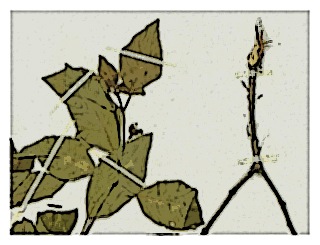
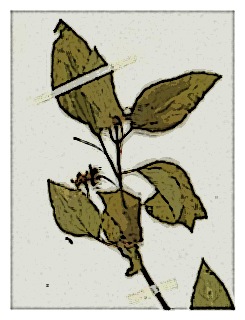
Fruit—The berry is globose to ellipsoid, 8 to 18 mm long, 7 to 13 mm thick, and dark red at maturity.
Seeds—Tan, 2 to 3 mm long, and 1 to 1.5 mm wide.
Chromosomes—Gametic chromosome number n. = 11.
Authors—Humboldt, Bonpland & Kunth 1823.
Original publication—Nov. Gen. Sp. 6: 104 1823.
Synonyms—F. quindunensis, Humboldt, Bonpland & Kunth 1823; F. curviflora, Bentham 1845; F. petiolaris var. bolivarensis, Munz 1943; F. petiolaris var. typica, Munz 1943; F. smithii, Munz 1943. Many regional forms.
Herbarium Specimens—Kew 1, Kew 2; New York 1, New York 2, New York 3, New York 4; Smithsonian.


F. pilosa Fielding & Gardner
Northern Peru. Endemic to mid-elevation cloud forest in the mountains east of the Rio Utcubamba in Amazonas department at elevations from 1,600 to 2,400 meters.
Habit—Shrub one to two meters tall with densely hirsute young growth, the hairs usually whitish, shaggy, erect, 1.0 to 1.6 mm long; older branches glabrescent, with light tan, finely striated bark.
Leaves—Opposite to quaternate, usually ternate, membranous, narrowly to broadly elliptic or oblanceolate, acute to attenuate at the base, acute to acuminate at the apex, 5 to 16 cm long, 2 to 7 cm wide, matte green and subglabrous to villous on upper surface, slightly paler and villous below; secondary veins 10 to 12 on either side of the midvein, sulcate above and prominent below, margin subentire. Petioles hirsute, 12 to 60 mm long. Stipules about 1 mm thick, prominent, lanceolate to triangular, 3 to 4 mm long, about 2 mm wide, often connate and recurved on lower nodes, persistent.
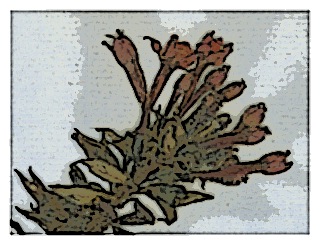
Flowers—Numerous and crowded at the tips of terminal, drooping racemes, rachis 3 to 2 0 cm long, bracts narrowly lanceolate, 5 to 15 mm long, pedicels slender, 3 to 5 mm long, about 1.5 mm thick, floral tube narrowly funnelform, 16 to 20 mm long, slightly bulbous and about 2 mm wide at the base, gradually widened above until 4 to 5 mm wide at the rim, sparsely to moderately hirsute outside, densely retrorse villous inside in Iower le, sepals lanceolate, long acuminate, 6 to 8 mm long, 2.5 to 3 mm wide, with free, divergent tips 2 to 3 mm long in bud, divergent with recurved tips at anthesis. Tube and sepals bright orange red, petals orange red, delicate, oblong-elliptic, 6 to 8 mm long, 3 to 4 mm wide, recurved at anthesis. Nectary unlobed, about 1mm high, filaments orange red, 4 to 5 mm and 2 to 3 mm long, anthers oblong, 1.5 to 2 mm long, about 1 mm wide, white, style glabrous, light red, stigma capitate, subtetragonous, 4-cleft apically, 1.5 to 2 .mm long, 2 to 3 mm wide, dull white, exserted 1 to 2 mm beyond the anthers.
Fruit—The berry is ellipsoid-oblong, 4-sulcate before maturity, 15 to 19 mm long, 10 to 12 mm thick, sparsely hirsute, and reddish.

Chromosomes—Gametic chromosome number n = 11.
Authors—Fielding & Gardner 1844.
Original publication—Sert. Pl. t. 27 1844.
Synonyms—F. asperifolia, Krause 1905.
Herbarium Specimens—Edinburgh 1, Edinburgh 2; Kew 1, Kew 2.
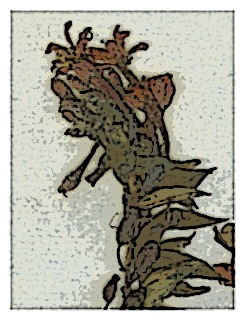

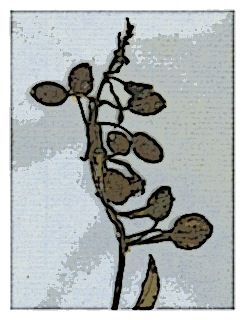
F. polyantha Killip
Columbia & Ecuador. Rare in cloud forest on the western slopes of the Cordillera Occidental from Nariño, Colombia south to Pichincha, Ecuador at elevations from 2,200 to 3,300 meters.
Habit—Erect shrubs one to two meters tall. Young growth minutely puberulent-canescent; branchlets puberulent, terete, purplish.
Leaves—Quaternate, firmly membranous, narrowly elliptic-lanceolate, acute to obtuse at the base, acuminate at the apex, 7 to 12 cm long, 2.5 to 4 cm wide, nitid dark green and subglabrous above, light green and sparsely puberulent below, especially along the veins; secondary veins 13 to 16 on either side of the midvein; margin subentire to serrate. Petioles puberulent, purplish, 3 to 10 mm long. Stipules dark, thick at the base, triangular, 1.5 to 2 mm long, about 1 mm wide, often connate and recurved when old, persistent.
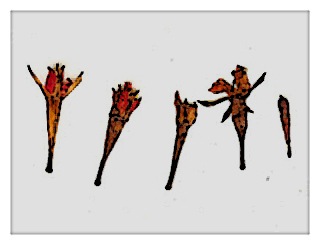
Flowers—Numerous in terminal, nodding, verticillately branched panicles, rachis 8 to 15 cm long, bracts narrowly lance-ovate, recurved, 10 to 30 mm long, 5 to 10 mm wide, pedicels puberulent, 5 to 10 mm long, ovary fusiform, puberulent, 6 to 7 mm long, about 2 mm thick, floral tube narrowly funnelform, 34~3 mm long, slightly nodose and 2.5 to 3.5 mm wide at the base, narrowed to about 2 mm above the nectary, then widened above until 5 to 7 mm wide ..at the rim, finely puberulent outside, pilose inside in lower ~, sepals narrowly lanceolate, acuminate, 10 to 15 mm long, about 3 mm wide, with a narrow tip 1.5 to 2 mm long in bud. Tube and sepals red, petals red, a little darker than the sepals, lanceolate to narrowly elliptic, subacuminate, 8 to 14 mm long, 2.5 to 4 mm wide. Nectary unlobed, about 1 mm high, filaments red, 8 to 11 mm and 6 to 7 mm long, anthers oblong, 2 to 2.5 mm long, about 1.5 mm wide, style red, sparsely pilose in lower ~, stigma capitate, slightly four-parted at the apex, 2 to 3 mm long, about 2 mm wide, dull white, exserted 3 to 4 mm beyond the anthers.
Fruit: Mature berries not seen, young ones oblong, 8 to 10 mm long, and 5 to 7 mm thick.

Seeds—Unknown. The seeds have not been described.
Chromosomes—Gametic chromosome number n = 11.
Authors—Killip 1943.
Original publication—Proc. Calif. Acad. Sci. IV, 25: 48 1943.
Synonyms—F. asperifolia, Krause 1905.
Herbarium Specimens—Field Museum; Smithsonian 1, Smithsonian 2.
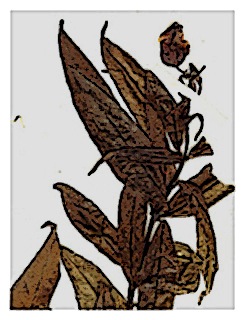
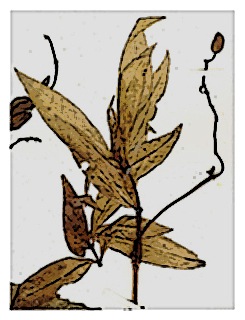
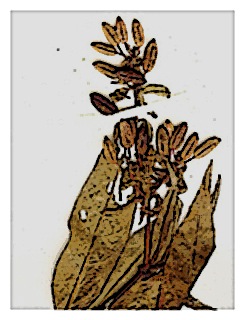
F. pringsheimii Urb.
Hispaniola (West Indies). In Haiti, in the southern Massif de la Hotte and Massif de la Selle ranges and in the central Chaîne des Matheux at elevations from 1,400 to 2,500 meters. In the Dominican Republic, in the southern Sierra de Baoruco, probably in the Sierra de Neiba, and in the Cordillera Central at elevations from (1,300 to) 1,500 to 2,600 meters as low shrubs mostly in pine forests.
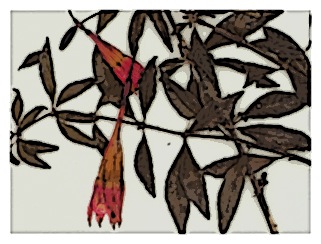
Habit—Erect to scandent shrubs one half to two meters tall with ascending to spreading branches. Branchlets terete, puberulent, pruinose, or rarely pilose, reddish purple; older stems with red brown, exfoliating bark.
Leaves—Opposite or ternate, subcoriaceous, narrowly (ob to) lanceolate to elliptic, acute to narrowly cuneate at the base, acute at the apex, 15 to 35 (to 40) mm long, 6 to 15 mm wide, dark rich green and glossy above, subglossy whitish-green to purplish below with red purple veins; upper surface glabrous to loosely strigose, strigose below, especially along the midvein and margin; secondary veins 3 to 5 on either side of the midvein; margin subentire to glandular-denticulate or dentate, sometimes only toothed in the upper half. Petioles sparsely strigose, 1 to 6 mm long, red purple. Stipules lanceolate, dark, 11.5 mm long, deciduous.
Flowers—Pendant and axillary near the branch tips, pedicels slender, subglabrous to loosely strigose, 14 to 40 mm long, ovary ellipsoid, 6 to 9 mm long, 2 to 3.5 mm thick, subglabrous, green to reddish, floral tube obconicfunnelform, 19 to 31 mm long, 3 to 4 mm wide and slightly bulbous at the base, then widened continuously until 9 to 16 mm wide at the rim, subglabrous outside, glabrous within, sepals lanceolate, acute to acuminate at the apex, 18 to 25 mm long, 6 to 8 mm wide, suberect to spreading at anthesis. Tube and sepals bright red to pink red, petals red to pink red, broadly obovate, emarginate to broadly truncate at the apex, 13 to 2 4 mm long, 10 to 15 mm wide, slightly spreading and convolute at the base at anthesis. Nectary a yellow-green band lining the basal 2 to 3 mm of the floral tube, irregularly-lobed and protruding slightly inwards from the tube, filaments red, 15 to 18 mm and 12 to 13 mm long, anthers oblong, 2.5 to 3 mm long, 1.5 to 2 mm wide, white to yellow cream, style red, glabrous, stigma clavate, 4-lobed at the apex,
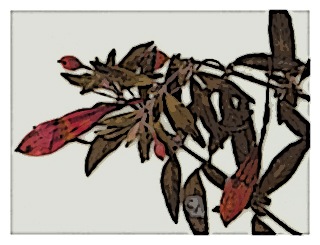
Fruit—The berry is oblong, about 15 mm long, and about 8 mm thick.
Seeds—About 2 mm thick, and about 1 mm wide.
Chromosomes—Gametic chromosome number n = 22.
Authors—Urban 1899.
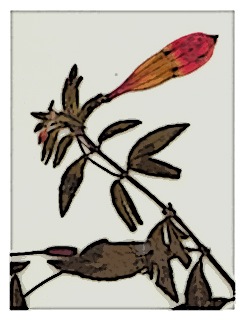
Synonyms—None.
Herbarium Specimens—Kew; New York 1, New York 2, New York 3, New York 4, New York 5, New York 6, New York 7, New York 8, New York 9, New York 10, New York 11, New York 12, New York 13, New York 14, New York 15, New York 16, New York 17, New York 18, New York 19, New York 20, New York 21, New York 22, New York 23, New York 24, New York 25, New York 26, New York 27, New York 28, New York, 29, New York 30, New York 31, New York 32, New York 33, New York 34, New York 35, New York 36, New York 37, New York 38, New York 39, New York 40, New York 41, New York 42, New York 43, New York 44, New York 45, New York 46, New York 47, New York 48, New York 49, New York 50, New York 51, New York 52, New York 53, New York 54, New York 55, New York 56, New York 57, New York 58, New York 59, New York 60, New York 61.
(Illustration—Fot the image see ➤ F. pringsheimii, Wikipedia, Scott Zona, Parque Nacional Valle Nuevo, Prov. La Vega, Dominican Republic, 2010.)
F. putumayensis Munz
Colombia and Ecuador. In low cloud forest in the Cordillera Occidental of Colombia from Antioquia to Valle, and on the eastern slopes of the Cordillera Central and Cordillera Oriental in Colombia and Ecuador, from Cauca south to Napo, at elevations from 1,400 to 2,100 meters.
Natural hybridization with F. nigricans is known to occur.
Habit—Shrubs or subshrubs one to three meters high. Young growth minutely puberulent; branchlets terete, 2 to 5 mm thick, green to dull purple; older stems pale tan gray, with finely fissured bark.
Leaves—Opposite, firmly membranous, elliptic, rounded to acute at the base, acute to subacuminate at the apex, 6 to 15 cm long, 3 to 7 cm wide, matte green and glabrous above, pale green and subglabrous to finely puberulent below along the subelevated nerves; secondary veins 9 to 13 on either side of the midvein, impressed above; margin subentire. Petioles 6 to 15 mm long, puberulent to subglabrous. Stipules lance-deltoid, thick at the base and subulate at the apex, occasionally connate, 1 to 2 mm long, 0.4 to 0.8 mm wide, deciduous.
Flowers—Numerous in mostly compact, terminal and subterminal racemes, rachis 1 to 4 (to 10) cm long, bracts lance-linear, 10 to 25 mm long, more-or-less recurved, often deciduous, pedicels slender, divergent, puberulent, 8 to 25 mm long, ovary oblong, 4 to 5 mm long, 1.5 to 2 mm thick, puberulent, reddish, floral tube narrowly funnelform, 15 to 27 mm long, 2 to 2.5 mm wide at the base, slightly constricted to 1.5 to 2 mm wide above the nectary, gradually widened above until 4 to 7 mm wide at the rim, finely puberulent outside, pubescent inside in the lower ~, sepals lanceolate, acuminate, 8 to 11 mm long, 3 to 5 mm wide, with a 1.5 to 2 mm long tip in bud, divergent at anthesis. Tube and sepals nitid orange to coral red, petals orange red, delicate, elliptic-oblong, 6 to 9 mm long, 3 to 4 mm wide, obtuse or mucronate at the apex, somewhat erose-margined, strongly spreading and recurved at anthesis. Nectary unlobed, 1 to 1.2 mm high, about 0.8 mm thick, filaments orange red, 4 to 6 mm and 2.5 to 4 mm long, anthers elliptic-oblong, 1.5 to 2.3 mm long, about 1 mm wide, cream, style glabrous, light red, stigma subglobose, slightly 4-lobed apically, cream to pink, exserted shortly above the anthers.
Fruit—The berry is oblong-ellipsoid, 10 to 12 mm long, 5 to 9 mm thick, and subnitid red purple.
Seeds—Tan, 1 to 1.2 mm long. and 0.6 to 0.8 mm wide.
Chromosomes—Gametic chromosome number n = 11.
Authors—Munz 1943.
Original publication—Proc. Calif. Acad. Sci. IV, 25: 41 1943.
Synonyms—None.
Herbarium Specimens—Field Museum; Smithsonian.
F. rivularis (2 subspecies)
F. rivularis subsp. rivularis J.F.Macbr.
Northern Peru. Locally frequent in thickets, frequently climbing up trees in forest openings, in mid-elevation cloud forest of Amazonas Department, east and northeast of Chachapoyas, at elevations from 2,100-2,600 meters, with a few collections also known from Cajamarca Department, Cutervo Province, at elevations from 1,900 to 2,650 meters.
Habit—Scandent shrubs or lianas to ten meters above ground, with long, flexuous-arcuate, mostly unbranched shoots to several meters long. Branchlets and young growth subglabrous to puberulent, older branches pilose or puberulent, glabrescent with age, with subnitid, red purple bark exfoliating in wide strips.
Leaves—Ternate or mostly quaternate, subcoriaceous, narrowly elliptic to elliptic, acute to obtuse at the base, narrowly acute to obtuse or subacuminate at the apex, 5 to 9 cm long, 2 to 5 cm wide, nitid dark green and subglabrous above, paler green and subglabrous to pilose below; secondary veins 13 to 15 on either side of the midvein, midrib elevated below; margin subentire to glandular-denticulate. Petioles stout, pilose, 3 to 6 mm long. Stipules triangular-lanceolate, 2 to 3 mm long, 0.8 to 1.3 mm wide, thick at the base, spreading, subpersistent.
Flowers—Few and pendant in uppermost leaf axils, pedicels drooping to subdivergent, puberulent, 10 to 53 mm long, ovary cylindrical, 6 to 8 mm long, 2 to 3 mm thick, generally pubescent, floral tube narrowly funnelform, 36 to 65 mm long, slightly bulbous at the base and 3 to 5 mm wide, narrowed to 2 to 4 mm wide above the nectary, then widened gradually above until (5 to) 6 to 10 mm wide at the rim, subglabrous to pilose or strigillose outside, pilose inside, sepals narrowly lanceolate, 16 to 20 mm long, 3 to 7 mm wide, with mostly free, spreading tips in bud 1~5 to 2.5 mm long, divergent at anthesis. Tube and sepals 'bright scarlet, petals orange red, oblong to lance-elliptic, 15 to 22 mm long, 4 to 7 mm wide, crispate-margined, often with a few, scattered hairs on the midvein dorsally, spreading-recurved at anthesis. Nectary light green, shallowly 4-lobed, 3 to 4 mm high, fused to the base of the tube in lower half, filaments red, 10 to 15 mm and 6 to 11 mm long, anthers narrowly oblong, 4 to 4.5 mm long, 1.5 to 2 mm wide, white, style red, usually glabrous, stigma subobconic, 3 to 4 mm long, 2 to 3 mm wide, lightly 4-cleft apically, light red.
Fruit—The berry is ellipsoid, 14 to 16 mm long, 8 to 10 mm thick, and reddish.
Seeds—Tan, 1.1 to 1.4 mm long, and 0.8 to 1.0 mm wide.
Chromosomes—Gametic chromosome number n = 11.
Authors—Macbride 1940.
Original publication—Candollea 8: 24 1940.
Synonyms—F. woytkowskii, Macbride 1941.
Herbarium Specimens— None on line.
F. rivularis subsp. pubescens P.E.Berry & Hermsen
Peru. Only known in cloud forest in Cajamarca in northern Peru at elevations between 2,000 and 2,500 meters.

Habit—Scandent shrub or liana to ten meters above ground, with long, flexuous-arcuate, mostly unbranched shoots to several meters long. Young growth densely puberulent, the branchlets with erect trichomes about 0.25 mm long, older branches with exfoliating brown to red-brown bark.
Leaves—In whorls of three or four, blades elliptic to obelliptic, 3 to 6 X 1 to 3 cm, apices variable from rounded and mucronate to obtuse or acute, bases acute to obtuse; upper leaf surface green and sparsely pubescent, the lower surface paler and densely pubescent in young leaves, with erect trichomes about 0.25 mm long, older leaves with trichomes persistent along the midvein and secondary veins of both surfaces, margins subentire to glandular-denticulate, secondary veins 13 to 15 on either side of the midvein, the midrib elevated on lower surface; petioles stout, pubescent, 2 to 4 mm long; stipules narrowly lanceolate, 1.5 to 2 mm long.
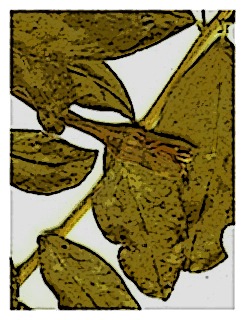
Flowers—To four per node, pendent in the uppermost leaf axils, pedicels drooping, pubescent, 12 to 18 mm long, 1 to 2 mm thick, floral tube narrowly funnelform, 47 to 58 mm long, 3 to 5 mm in diameter. at the slightly bulbous base, narrowing to 2 to 4 mm wide above, then widening again to about 8 mm wide at the rim, pubescent outside, more sparsely pubescent inside, sepal lobes 4, spreading at anthesis, narrowly lanceolate, 16 to 17 mm long, about 4 mm wide at the base, the distalmost 2 to 3 mm free in bud, densely pubescent outside, glabrous inside, petals 4, glabrous, narrowly elliptic, 16 to 18 mm long, 4 to 5 mm wide at the midpoint, stamens 8, the antesepalous ones 1213 mm long, the antepetalous ones 8 to 9 mm long, anthers about 4 long, 1.5 mm wide, ovary cylindrical, about 7 long, 2 mm in diameter, style sparsely pubescent and protruding from the floral tube, stigma capitate, slightly 4lobed at the apex, 2 to 2.5 mm long, about 1.5 mm wide.

Fruit—Unripe berries oblong, 8 to 12 mm long, 3 to 6 mm thick, and densely pubescent.
Seeds—Unknown.
Chromosomes—Gametic chromosome number is unknown.
Authors—Berry & Hermsen 1999.
Original publication—Novon 9: 4 1999 479-482.
Synonyms—None.
Herbarium Specimens—Field Museum.
F. sanctae-rosae Kuntze
Southern Peru and Bolivia. Scattered to locally frequent in cloud forest from Cuzco Department in Peru to Cochabamba Department in Bolivia at elevations from 1,400 to 3,000 meters.

Leaves—In whorls of three or four, blades elliptic to obelliptic, 3 to 6 X 1 to 3 cm, apices variable from rounded and mucronate to obtuse or acute, bases acute to obtuse; upper leaf surface green and sparsely pubescent, the lower surface paler and densely pubescent in young leaves, with erect trichomes about 0.25 mm long, older leaves with trichomes persistent along the midvein and secondary veins of both surfaces, margins subentire to glandular-denticulate, secondary veins 13 to 15 on either side of the midvein, the midrib elevated on lower surface; petioles stout, pubescent, 2 to 4 mm long; stipules narrowly lanceolate, 1.5 to 2 mm long.
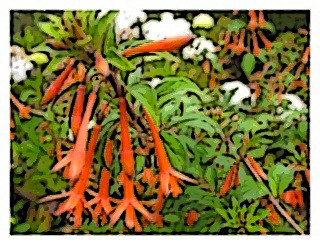
Flowers—To four per node, pendent in the uppermost leaf axils, pedicels drooping, pubescent, 12 to 18 mm long, 1 to 2 mm thick, floral tube narrowly funnelform, 47 to 58 mm long, 3 to 5 mm in diameter. at the slightly bulbous base, narrowing to 2 to 4 mm wide above, then widening again to about 8 mm wide at the rim, pubescent outside, more sparsely pubescent inside, sepal lobes 4, spreading at anthesis, narrowly lanceolate, 16 to 17 mm long, about 4 mm wide at the base, the distalmost 2 to 3 mm free in bud, densely pubescent outside, glabrous inside, petals 4, glabrous, narrowly elliptic, 16 to 18 mm long, 4 to 5 mm wide at the midpoint, stamens 8, the antesepalous ones 1213 mm long, the antepetalous ones 8 to 9 mm long, anthers about 4 long, 1.5 mm wide, ovary cylindrical, about 7 long, 2 mm in diameter, style sparsely pubescent and protruding from the floral tube, stigma capitate, slightly 4lobed at the apex, 2 to 2.5 mm long, about 1.5 mm wide.
Fruit—Unripe berries oblong, 8 to 12 mm long, 3 to 6 mm thick, and densely pubescent.
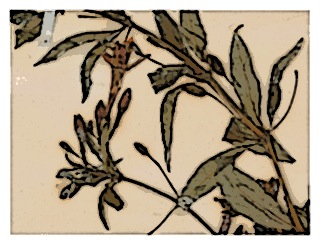
Chromosomes—Gametic chromosome number is unknown.
Authors—Kuntze 1898.
Original publication—Revis. Gen. Pl. 3(2): 98 1898.
Synonyms—F. boliviana, Britton 1890; F. weberbaueri, Krause 1905; F. brittonii, Johnston 1925; F. filipes, Rusby 1927.
Herbarium Specimens— New York 1, New York 2, New York 3; Smithsonian 1, Smithsonian 2.
F. sanmartina P.E.Berry
Peru. Known only from the type locality and its near vicinity on the eastern slopes of San Martín Department, Peru, at elevations from 2,800 to 3,600 meters.

Habit—Scandent shrubs 1.5 to 3 meters high or lianas to 10 meters above ground. Young growth finely puberulent-velutinous, branchlets mostly subtriangular in transection.
Leaves—Mostly temate, occasionally opposite, firmly membranous, narrowly elliptic-ovate, obtuse to rounded or unequal at the base, acute to acuminate at the apex, 5 to 15 cm long, 1.5 to 6 cm wide, subglabrous to puberulent above, puberulent below, especially along the veins; secondary veins 9 to 11 on either side of the midvein; margin subentire to denticulate.
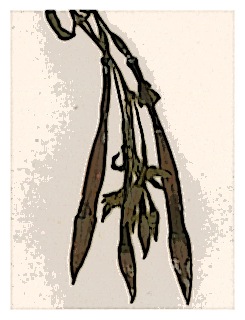
Flowers—Numerous and pendant in terminal racemes, rachis puberulent, 7 to 16 cm long, bracts 8 to 50 mm long, 5 to 25 mm wide, with petioles 1 to 8 mm long, pedicels puberulent, 13 to 50 mm long, ovary oblong, 7 to 8 mm long, about 2 mm thick, floral tube subcylindric, 55 to 76 mm long, bulbous and 3 to 4 mm wide at the base, then narrowed to,2 to 3 mm wide above the nectary, slightly widened above until 6 to 8 mm wide at the rim, puberulent outside, pilose inside, sepals lanceolate, acuminate, 20 to 25 mm long, 4 to 5 mm wide, the tips slightly spreading in bud. Tube and sepals bright red, petals red, narrowly lance-elliptic, acute, 10 to 16 mm long, 3 to 6 mm wide. Nectary unlobed, about 2 mm high, filaments 14 to 15 mm and 9 to 11 mm long, anthers oblong, 3.5 to 4 mm long, 1.5 to 2 mm wide, style pilose, stigma 3 to 4 mm long and 2.5 to 3 mm wide, four-parted at the apex.
Fruit—Unknown.
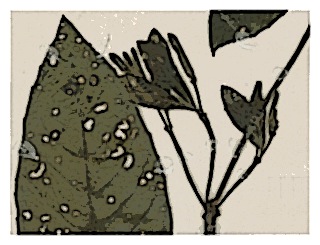
Seeds—Unknown.
Chromosomes—Gametic chromosome number is unknown.
Authors—Berry 1982.
Original publication—Ann. Missouri Bot. Gard. 69: 79 1982.
Synonyms—None.
Herbarium Specimens— Kew; New York.
F. scabriuscula Benth.
Ecuador and southern Colombia. Locally frequent in clearings, thickets, and moist banks of cloud forest, in Ecuador in Napo, Pichincha, and Tungurahua Provinces, on both the east and west slopes of the Andes, and in Colombia, on the eastern slopes of the Nudo de Pasto in Putumayo, in the Cordillera Central as far north as Valle, and in the Cordillera Oriental to the Cauca-Huila border, all at elevations from 1,400 to 2,750 meters.
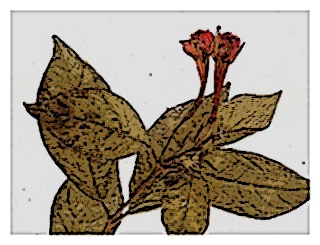
Habit—Decumbent to erect shrubs one half to two and a half meters tall. Branchlets subterete, 2 to 5 mm thick, pilose-hispidulous with suberect, whitish hairs; older branches with tan, exfoliating bark.
Leaves—Opposite, very rarely temate, membranous, with finely reticulate, rugulose venation, elliptic to slightly ovate, acute to rounded at the base, acute to acuminate at the apex, 2.5 to 12 (to 14) cm long, 1.5 to 5 (to 6) cm wide, dull green and strigose above, pale green to flushed purple and strigose below, especially along the veins; secondary veins 8 to 14 on either side of the midvein, subelevated below; margin subentire. Petioles densely pilose, 5 to 25 mm long. Stipules lance-linear, 2 to 3.5 mm long, thick at the base, terminating in a long, dark, filiform tip, subpersistent.

Flowers—Few and solitary in upper leaf axils, pedicels divergent to drooping, pilose, 10 to 25 mm long, ovary oblong, 5 to 6 mm long, 2 to 3 mm thick, strigose to hispidulous, green, floral tube narrowly funnel-form, 15 to 27 mm long, 2 to 3 mm wide at the base, slightly narrowed to 1.5 to 2.5 mm wide above the nectary and gradually widened above until 5 to 7 mm wide at the rim, strigose to hispidulous outside, densely pilose inside in lower 1,2, sepals lanceolate, 9 to 12 mm long, 3 to 4 mm wide, acuminate, tips mostly free in bud, spreading at anthesis. Tube and sepals whitish pink to red, petals pink to scarlet, elliptic-oblong, 7 to 10 mm long, 3 to 4.5 mm wide, broadly acute to rounded at the apex, spreading at anthesis. Nectary usually unlobed, green, about 1.5 mm high, filaments red to pink, 5 to 7 mm and 3 to 5 mm long, anthers elliptic-oblong, 1.5 to 2 mm long, about 1 mm wide, bright white, style densely villous for most its length, pink, stigma subglobose, 4-cleft at the apex, about 2 mm long and about 2 mm wide, exserted 1 to 4 mm beyond the anthers, white.
Fruit—The berry is oblong before maturity, becoming subglobose when ripe, and usually deep, nitid purple.
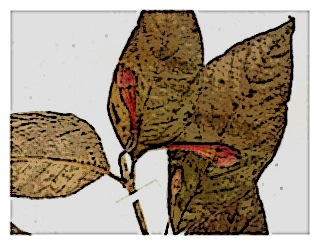
Seeds—Tan to bright purple, 1 to 1.3 mm long, and 0.8 to 1.0 mm wide.
Chromosomes—Gametic chromosome number is unknown.
Authors—Bentham 1845.
Original publication—Pl. Hartw. 177 1845.
Synonyms—None.
Herbarium Specimens—Field Museum; Kew 1, Kew 2.
F. scherffiana André
Southern Ecuador. Known only from the Nudo de Sabanilla area near the border of Loja and Zamora-Chinchipe Provinces at about 2,800 meters in elevation.
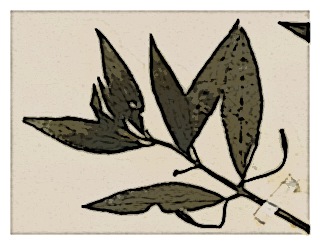
Natural hybridization with F. steyermrkii is known to occur.
Habit—Erect to scandent shrubs 0.5 to 3 meters tall with spreading branches. Branchlets canescent-strigillose, terete, 1 to 2.5 mm thick, purplish; older stems 3 to 10 mm thick, dull purple.
Leaves—Opposite or occasionally ternate, firmly membranous, (very) narrowly elliptic to narrowly lanceolate, acute at the base, acute to acuminate at the apex, 2.5 to 10 cm long, 0.8 to 2.3 cm wide, (very) dark nitid green and strigose above, shiny green to metallic purple and strigose with long villous hairs along the midvein below; secondary veins 6 to 10 on either side of the midvein; margin subentire to slightly revolute. Petioles strigose, purplish, 4 to 15 mm long. Stipules lance-linear, dark, 1 to 2 mm long, about 0.3 mm wide, subpersistent.
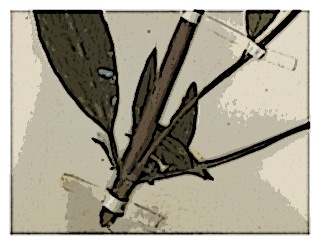
Flowers—Few and axillary, pendant, pedicels strigillose, 15 to 20 mm long, ovary oblong, strongly tetragonous, 7 to 8 mm long, 1.5 to 2 mm thick, greenish, floral tube narrowly funnelform, 44 to 50 mm long, 2.5 to 4 mm wide and slightly bulbous at the base, narrowed to 2 to 2.5 mm wide above the nectary, gradually widened above until 7 to 8 mm wide at the rim, sparsely strigose outside, villous inside in lower ~, sepals lanceolate, acuminate, 12 to 14 mm long, 3.5 to 5 mm wide, spreading at anthesis. Tube and sepals orange red, petals red, narrowly elliptic-lanceolate, (narrowly) acute at the apex, 9 to 11 mm long, 3 to 5 mm wide. Nectary green, unlobed, about 1 mm high, filaments red, 8 to 10 mm and 6 to 8 mm long, anthers oblong, 3 to 3.5 mm long, about 1.5 mm wide, cream, style red, villous for about %. its length from the base, stigma globose, about 2 mm wide, 1.5 to 1.8 mm wide, reddish.
Fruit—The berry is oblong, tetragonous, green before maturity, about 15 mm long, and about 6 mm thick; mature fruits not seen.
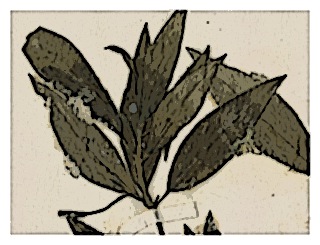
Seeds—Unknown.
Chromosomes—Gametic chromosome number is unknown.
Authors—André 1888.
Original publication—Rev. Hort. 60: 233 1888.
Synonyms—None.
Herbarium Specimens—Kew.
F. sessilifolia Benth.
Ecuador and Colombia. In the Cordillera Occidental of the Northern Andes from Pichincha, Ecuador to Choco and Antioquia, Colombia; in the Cordillera Central from northern Napo to Tolima; and in the Cordillera Oriental from Putumayo to Huila; cloud forest shrubs in thickets, stream banks, and forest openings at elevations from 2,300 to 3,200 meters.
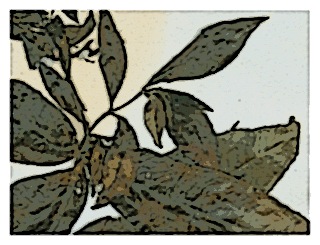
Habit—Erect to scandent shrubs one half to three meters tall with few, erect to mostly arcuate branches. Young growth finely puberulent, branchlets subtetragonous, cinereous-puberulent, 2 to 6 mm thick, wine red; older branches 5 to 15 mm thick, with exfoliating bark.
Leaves—Verticillate, mostly quaternate, subsessile, membranous to subcoriaceous, narrowly elliptic to elliptic or oblanceolate, rounded to attenuate or narrowly subcordate at the base, acute to acuminate at the apex, 6 to 20 cm long, 2 to 6 (to 8) cm wide, lustrous dark green and subglabrous above, pale green to purplish and pubescent to subglabrous below; secondary veins 18 to 25 on either side of the midvein, impressed above, the midvein prominent below; margin serrulate and commonly undulate. Petioles 1 to 5 mm long, dull red. Stipules triangular, thickened at the base, 1 to 2 mm long, about 1 mm wide, mostly deciduous.
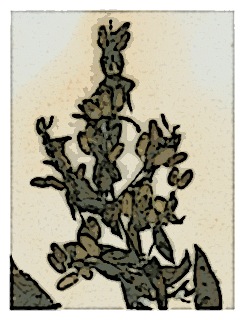
Flowers—Numerous in terminal, drooping, verticillately-branched panicles, rachis 5 to 30 cm long, bracts lanceolate, 10 to 35 mm long, 4 to 10 mm wide, often reflexed, pedicels slender, strigillose, 3 to 5 (to 8) mm long, ovary cylindrical, 5 to 6 mm long, 1.5 to 2.5 mm thick, finely strigose, floral tube narrowlyfunnelform, 13 to 18 (to 20) mm long, 2 to 3 mm wide at the base.inarrowed slightly to 1 to 2 mm above the nectary, gradually widened above until 4 to 5 mm wide at the rim, finely strigose outside, pilose inside, sepals lanceolate, 8 to 11 mm long, 3 to 4 mm wide, acute to acuminate, forming a short point 1 to 2 mm long in bud, spreading at anthesis. Tube pale cream to rose green or light red, sepals light yellow green to light pink, petals bright scarlet, contrasting with the lighter sepals and tube, elliptic-oblanceolate, 6 to 9 mm long, 3 to 4 mm wide in the middle, acute to rounded at the apex, spreading at anthesis. Nectary unlobed, about 1 mm high, filaments red to greenish red, 5 to 8 mm and 3.5 to 5 mm long, anthers oblong, 1.5 to 2 mm long, about 1mm wide, pale yellow, style glabrous to loosely pilose, stigma capitate, four-parted at the apex, 1.5 to 2 mm long, 1.5 to 2 mm wide, cream, situated at the level of the anthers or slightly exserted.
Fruit—The berry is cylindric-oblong, 15 to 19 mm long, 8 to 11 mm thick, and green to nitid purple.
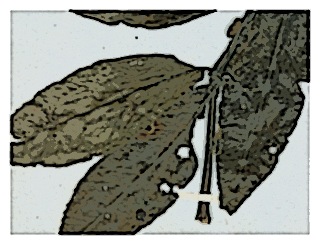
Seeds—Reddish purple to tan, 1.5 to 2 mm long, and about 1mm wide.
Chromosomes—Gametic chromosome number n = 11.
Authors—Bentham 1845.
Original publication—Pl. Hartw. 176 1845.
Synonyms—None.
Herbarium Specimens—Kew 1, Kew 2.
F. simplicicaulis Ruiz & Pav.
Central Peru. Rare in cloud forests in Huánuco, Junín, and Pasco Departments on eastern slopes of the Andes at elevations from 2,200 to 2,500 meters
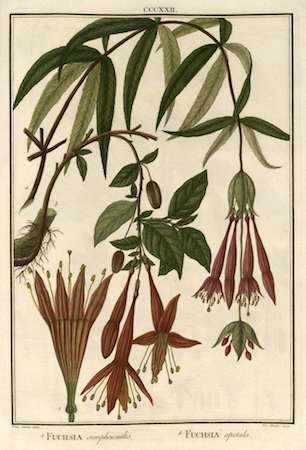
Leaves—Ternate or quaternate, membranous, linear-lanceolate to ovate-lanceolate, acute to narrowly obtuse or truncate at the base, acuminate at the apex, 8 to 15 cm long, 1 to 3.5 cm wide, glabrous above, glabrous to scattered pilose below or along the margin; secondary veins 10 to 18 on either side of the midvein; margin subentire. Petioles glabrous to puberulent, 2 to 6 mm long. Stipules triangular, 1 to 2 mm long, about 0.9 mm wide, subpersistent.
Flowers—In simple to multiple, pendant, involucrate racemes, with flowers three to four per whorl and internodes 1.5 to 6 cm long, rachis 8 to 30 cm long, bracts thinly membranous, sessile, concave, ovate-lanceolate, broadly rounded and clasping the stem at the base, acuminate at the apex, 1 to 5 cm long, 0.5 to 1.5 cm wide, pedicels puberulent, 5 to 10 mm long, ovary oblong-ellipsoid, puberulent or velutinous, 5 to 6 mm long, 2 to 2.5 mm thick, floral tube narrowly funnelform, 40 to 50 mm long, bulbous and 3 to 4 mm wide at the base, narrowed to 1.5 to 2 mm wide above the ovary, then gradually widened above until 5 to 7 mm wide at the rim, finely pilose outside, pilose inside, sepals lanceolate, puberulent on both sides, acuminate, 16 to 20 mm long, about 4 mm wide. Tube and sepals light reddish pink, petals red, linear-lanceolate to elliptic, acute to narrowly acuminate at the apex, 9 to 13 mm long, 2 to 3 (to 5) mm wide. Nectary apparently unlobed, about 1.5 mm high, filaments 10 to 12 mm and 7 to 8 mm long, anthers oblong, 3 to 4 mm long, about 2 mm wide, style pilose from base up to the rim of the tube, stigma globose, four-parted at the apex, 2.5 to 3.5 mm long, about 2 mm wide.
Fruit—The berry is ellipsoid, puberulent, 11 to 13 mm long, and about 8 mm thick.
Seeds—Tan, about 1.2 mm long, and about 0.7 mm wide.
Chromosomes—Gametic chromosome number is unknown.
Authors—Ruiz & Pavon 1802.
Original publication—Fl. Peruv. 3: 89 1802.
Synonyms—None.
Herbarium Specimens— Madrid.
Images—Field Museum.
Botanical illustration—Ruiz Lopez, H. and Pavon, J., Flora Peruviana, et Chilensis, Plates 1-152, vol. 2 (colored version): p. 89, t. 322, fig. a, (1798-1802).
F. steyermarkii P.E.Berry
Ecuador. Known only from the type locality on the eastern slopes of the Andes in southernmost Ecuador. Santiago-Zamora in deep forest along the Río Valladolid between the west side of the Río Valladolid at Tambo Vallodolid to the Río Molino above Tambo Vallodolid and between Rancho Achupallas and Tambo Valladolid. At elevations from 1,800 to 2,000 meters.
Habit—Densely pilose, many-branched shrub about 2 meters tall. Branchlets subterete, 1.5 to 4 mm thick, pilose, with copper-colored bark.
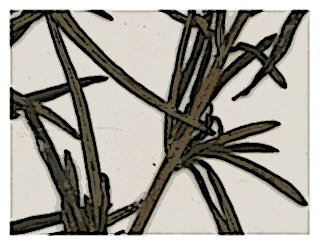
Leaves—Opposite to quaternate but usually appearing fasciculate due to the very reduced lateral shoots, firmly membranous, linear, acute at both ends; 20 to 70 mm long, 2 to 3 mm wide, subglossy dark green and sparsely strigose above, pale and densely pilose below along central nerve and margin; secondary veins mostly inconspicuous, midvein strongly prominent below, margin strongly revolute. Petioles 0.2 to 2 mm long. Stipules dark, lance-linear, about 1.5 mm long, subpersistent.
Flowers—Few and axillary near the branch tips, pedicels 16 to 18 mm long, ovary oblong, 4 to 5 mm and about 2 mm thick, floral tube narrowly funnelform, 33 to 37 mm long, 2.5 to 3 mm wide and bulbous at the base, narrowed to about 2 mm wide above the nectary and gradually widened above until 5 to 6 mm wide at the rim, loosely strigose-pilose outside, pilose inside in lower ~, sepals lanceolate, acuminate, 13 to 15 mm long, 3 to 4 mm wide. Tube and sepals rose red, petals scarlet, lanceolate, acute to subacuminate at the apex, 9 to 10 mm long, about 3 mm wide. Nectary unlobed, about 1.5 mm high, filaments red, 8 to 9 mm and 6 to 7 mm long, anthers oblong, 2.5 to 3 mm long and about 2 mm wide, cream yellow, style red, loosely villous for most of its length, stigma capitate, slightly 4-lobed at the apex, 2 mm long, 2 to 3 mm wide, exserted 1 to 3 mm. beyond the anthers.
Fruit—Unknown.
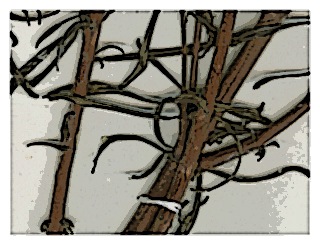
Seeds—Unknown.
Chromosomes—Gametic chromosome number is unknown.
Authors—Berry 1982.
Original publication—Ann. Missouri Bot. Gard. 69: 79 1982.
Synonyms—None.
Herbarium Specimens— New York.

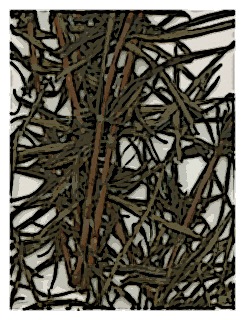
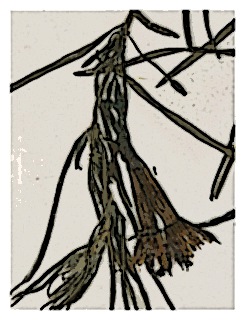
F. summa P.E.Berry
Ecuador. Loja. Found on the road from Yangana to Cerro Toledo in open patches above the tree line at elevations from 3,100 to 3,450 meters.

This is a low shrub one half meter tall. The dark-green, subcoriaceous leaves are densely packed along the stems. The tube and sepals are four-angled. The sepals are slightly shorter than the petals and have green tips.
Fruit—Unknown.
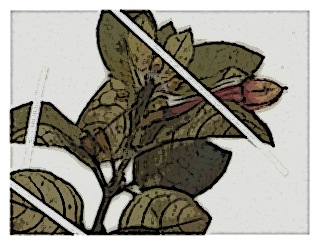
Seeds—Unknown.
Chromosomes—Gametic chromosome number unknown.
Authors—Berry 1995.
Original publication—Novon 5: 320 1995.
Synonyms—None.
Herbarium Specimens—Missouri; Smithsonian.
F. sylvatica Benth.
Ecuador. On the western slopes of the Andes from Cotopaxi to Imbabura Provinces, in mid-elevation cloud forest, growing in moist soil in thickets, along streams, or on roadside banks at elevations from 2,600 to 3,100 meters.
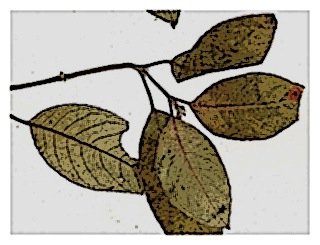
Habit—Erect to scandent shrubs 1 to 2.5 meters tall. Young growth finely canescent; older stems with tan, fissured bark.
Leaves—Mostly ternate, opposite, or rarely quaternate, membranous, finely reticulate-veined and sometimes rugulose, elliptic to (ob- to) ovate, acute to attenuate at the base, mostly acute at the apex, 4 to 15 cm long, 2 to 8 cm wide, medium-dark green and strigillose above, pale green to tinged red and strigillose below; secondary veins 11 to 18 on either side of the midvein; margin remotely gland-denticulate. Petioles strigillose, 6 to 34 mm long. Stipules dark purple, narrowly triangular, 1 to 2 mm long, about 0.7 mm wide, thick at the base, subulate at the apex, subpersistent.
Flowers—Generally numerous in long, straggly, terminal or subterminal racemes, rachis arching-pendant or sometimes more-or-less 'twisted, 5 to 20 cm long, bracts ovate-
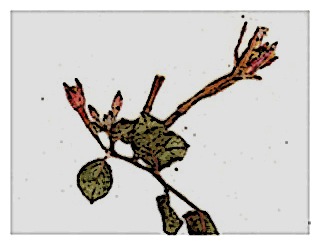
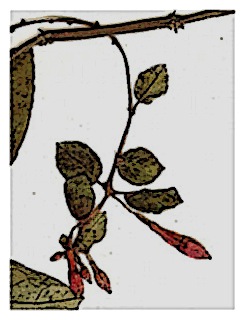
Fruit—The berry is subcylindric-fusiform, gradually narrowed towards the apex, more-or-less verrucose before maturity, 13 to 17 mm long, 5 to 7 mm thick, and red purple to subtranslucent.
Seeds—ca. 1.5 mm long, and about 0.8 mm wide.
Chromosomes—Gametic chromosome number unknown.
Authors—Bentham 1845.
Original publication—Pl. Hartw. 176 1845.
Synonyms—None.
Herbarium Specimens—Field Museum; Kew 1, Kew 2; Paris.
F. tincta I.M.Jonst.
Peru. Endemic to Cuzco Department and locally common in damp, shady thickets along streams and roadsides, on the eastern slopes of the Andes in the Pillahuata area between Paucartambo, and Pilcopata and also known from Convención Province farther north, all at elevations from 1,800 to 2,400 (to 2,800) meters.
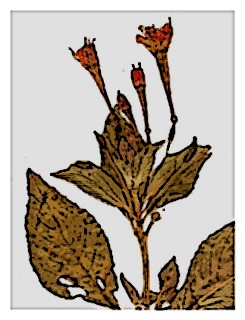
Natural hybridization with F. sanctae-rosae is known to occur.
Habit—Erect subshrubs one half to one and a half meters tall. Young growth whitish pilose, turning tan to reddish-brown with age; older stems 4 to 10 mm thick, with light brown, striated bark.
Leaves—Opposite or sometimes subopposite near the branch tips, softly membranous, ovate-elliptic to broadly ovate, acute to rounded or unequal at the base, acute to acuminate at the apex, 3 to 14 cm long, 1.5 to 9 cm wide, velvety dark green and strigillose above, pale green or commonly purple flushed and strigose below, pubescence denser along the nerves; secondary veins 11 to 18 on either side of the midvein, sulcate above; margin glandular-denticulate to coarsely dentate. Petioles strigose, 13 to 50 mm long. Stipules lanceolate, dark, 1 to 2 mm long, subpersistent.

Flowers—Usually five to ten and nodding in a generally compact, terminal, corymbose raceme, rachis 1.5 to 7 cm long, pedicels slender, strigose, 18 to 30 mm long, ascending in bud to divergent at anthesis, ovary cylindric-fusiform, 6 to 8 mm long, 1 to 2 mm thick, floral tube narrowly funnelform, 16 to 23 mm long, 1.5 to 2.5 mm wide and slightly bulbous at the base, narrowed to 1 to 1.5 mm above the nectary, then widened gradually above until 3 to 5 mm wide at the rim, pilose outside, retrorse villous inside in lower ~, sepals lanceolate, 7 to 9 mm long, 3 to 4 mm wide, acute, spreading at anthesis, Tube and sepals pink to bright red, petals pink to red, oblong, 6 to 9 mm long, 3 to 5 mm wide, obtuse to mucronate at the apex, spreading at anthesis. Nectary unlobed or shallowly 4-lobed, about 1.5 mm high, filaments pink to red, 5 to 7 mm and 3 to 4 mm long, anthers oblong, about 2 mm long, about 1.2 mm wide, white, style light red, retrorse villous in lower ~, stigma capitate, 1.5 to 2 mm long, 1.5 to 2 mm wide, four-parted at the apex, white to light pink, exserted 2 to 3 mm beyond the anthers.
Fruit—The berry is ellipsoid to subglobose, 13 to 17 mm long, and 8 to 11 mm thick.

Chromosomes—Gametic chromosome number n = 11.
Authors—Johnston 1939.
Original publication—J. Arnold Arbor. 20: 242 1939.
Synonyms—None.
Herbarium Specimens—Field Museum 1, Field Museum 2.
Images—Field Museum.
F. triphylla L.
Hispaniola (West Indies). In Haiti, in the southern Massif de la Hotte and Massif de la Selle, in the central Chaîne des Matheux, and (rare) in the northern range in the Montagnes Noires and Chaîne de Plaisance and in the Dominican Republic, in the southern Sierra de Baoruco, in the central Sierra de Neiba, and in the northern Cordillera Central on exposed slopes, moist banks, and edges of pine and mixed pine-broadleaf forest at elevations from (700 to) 1,100 to 2,000 meters.
Natural hybridization with F. pringsheimii is known to occur. [According to Dr. Paul E. Berry, professor, director and curator at the University of Michigan's Herbarium, and the world's leading scientific authority currently working on the genus, he will likely describe a new subspecies from the southern Dominican Republic as F. triphylla subsp. angustifolia in a future publication.]
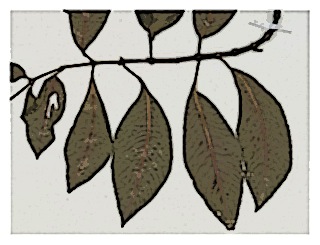
Habit—Subshrub to low shrub thirty centimeters to two meters tall with erect to drooping branches. Young growth canescent to short pilose; branchlets pubescent, reddish; older branches with tan, exfoliating bark.
Leaves—Opposite or ternate, rarely quaternate, firmly membranous, narrowly lanceolate to elliptic or oblanceolate, acute to narrowly cuneate at the base, acute to acuminate at the apex, 2.5 to 10 (to 13) cm long, 1 to 4 (to 5.5) cm wide, dull medium to dark green and strigillose above, pale green to commonly flushed metallic purple and strigose below; secondary veins (6 to) 7 to 13 on either side of the midvein, mostly impressed above, elevated and often reddish below; margin subentire to finely denticulate. Petioles pubescent, 4 to 15 (to 25) mm long. Stipules lance-linear, 1.5 to 3 mm long, mostly deciduous.
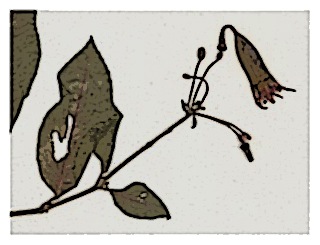
Flowers—Numerous in suberect to mostly nodding, terminal racemes, occasionally subracemose, rachis 4 to 12 (to 15) cm long, leaves subtending the flowers mostly reduced, narrowly lanceolate, and deciduous, but similar to normal leaves if flowers subracemose, pedicels lightly pilose, 10 to 30 mm long, divergent to nodding, ovary ellipsoid, 57 mm long, 1.5 to 2.5 mm wide, floral tube 25 to 40 mm long, 2 to 3.5 and bulbous at the base, sometimes with a ring-like inflation of the tube at the base surrounding the nectary, constricted rather strongly to 1 to 2.5 mm wide in the lower (6 to) 10 to 18 mm of the tube, then abruptly dilated to 8 to 11 mm wide before narrowing slightly towards the rim, pubescent outside, glabrous inside, sepals lanceolate, 10 to 13 mm long, 3.5 to 4.5 mm wide, spreading at anthesis. Tube and sepals orange to coral red, petals orange to coral red, elliptic-ovate, rounded to broadly acute at the apex, 6 to 9 mm long, 4 to 6 mm wide, suberect to spreading at anthesis. Nectary shallowly 8-lobed, about 1 mm high, filaments orange red, 5 to 7 mm and 3 to 4 mm "long, anthers oblong, about 2.5 mm long, about 1.5 mm wide, cream, style orange red, glabrous, stigma capitate, slightly 4-lobed at the apex, about 1.5 mm long and wide, pale red.
Fruit—The berry is subglobose to ellipsoid, strigose and more-or-less 4-angled before maturity, 15 to 18 mm long, 11 to 13 mm thick, and glossy red purple when ripe.
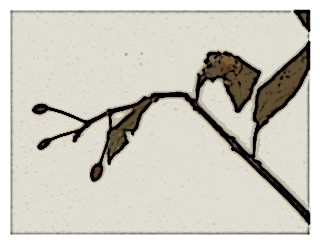
Seeds—Tan, 1.8 to 2.1 mm long, and about 1 mm wide.
Chromosomes—Gametic chromosome number n = 22.
Authors—Plumier 1703. Linnaeus 1753.
Original publication—Sp. Pl. 1191 1753.
Synonyms—F. racemosa, Lamarck 1788.
Herbarium Specimens—Missouri 1; Missouri 2.
F. vargasiana Munz ex Vargas
Peru. Endemic to Cuzco Department and locally frequent in moist shady thickets along the Rio Tambomayo, Pillahuata area of Paucartambo Province at elevations from 1,700 to 2,300 meters.

Habit—Erect shrubs one to two meters tall. Young growth finely soft pilose with white to rusty hairs; older branches 4 to 10mm thick, dull tan-brown.
Leaves—Opposite, membranous, narrowly ovate-elliptic to narrowly subdeltoid, rounded to obtuse or unequal at the base, acuminate at the apex, 6 to 23 cm long, 2.5 to 9 cm wide, subnitid dark green and sparsely strigose to subglabrous above, pale green below and finely pilose mostly along the veins; secondary veins 12 to 18 on either side of the midvein; margin glandular-serrulate or denticulate. Petioles pubescent, 12 to 60 mm long. Stipules lanceolate, dark, 1 to 2 mm long, about 0.4 mm wide, deciduous.

Fruit—The berry is narrowly cylindrical-fusiform, often curved and usually constricted at the apex, 25 to 32 mm long, and about 8 mm thick.
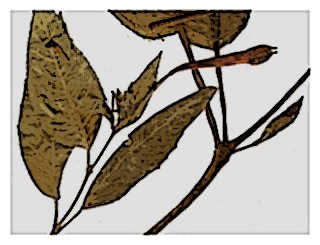
Seeds—1.3 to 1.6 mm long, and 0.9 to 1.1 mm wide.
Chromosomes—Gametic chromosome number n = 11.
Authors—Munz ex Vargas 1946.
Original publication—Diez Anos Servic. Bot. Univ. Cuzco 50 1946.
Synonyms—None.
Herbarium Specimens—Field Museum.
Images—Field Museum.
F. venusta Kunth
Colombia and Venezuela. Locally frequent to scattered along forest edges, stream sides, thickets or in trees of mid-elevation cloud forest, in Venezuela, from Mérida to Táchira, in Colombia in the Cordillera Oriental from Santander to Huila, and in the Cordillera Central in Tolima, all at elevations from 1,800 to 2,700 meters.
Natural hybridization with F. hirtella, F. nigricans and F. gehrigeri is known to occur.

Habit—Erect to scandent shrubs one to three meters tall or lianas to 10 meters above ground, with suberect or long, flexuous-pendant branches to several meters long. Branchlets terete to subtriangular, 2 to 6 mm thick, minutely puberulent to finely hirtellous, dull wine .red to bluish purple; older branches 10 to 40 mm thick, with tan, exfoliating bark.
Leaves—Ternate, rarely opposite or quaternate, firmly membranous to subcoriaceous, elliptic, rounded to acute at the base, acute to subacuminate at the apex, 5 to 11.5 cm long, 1.5 to 4.5 cm wide, glossy dark green and subglabrous above, glossy pale green and subglabrous to pubescent along the nerves below; secondary veins 7 to 12 on either side of the midvein, impressed above, subelevated below; margin subentire. Petioles puberulent or strigillose, 4 to 10 (to 12) mm long, wine red. Stipules lance-deltoid, 1 to 1.5 mm long, about 0.4 mm wide, subulate at the apex, deciduous.
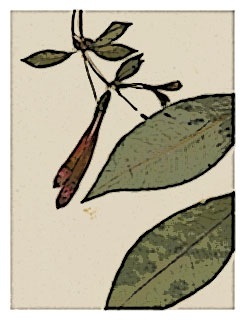
Flowers—Axillary in uppermost leafaxils or subracemose at branch tips, when subracemose, rachis 2 to 4 cm long, subtending leaves usually deciduous, pedicels slender to filiform, ascending to divergent in bud, arching or drooping by anthesis, (10 to) 15 to 30 (to 60) mm long, glabrous to pubescent, ovary oblong to ellipsoid, 4 to 8 meters.mlong, 2 to 3 mm thick, floral tube narrowly funnelform, (30 to) 35 to 60 mm long, 2.5 to 4.5 mm wide and slightly bulbous at the base, narrowed to 2 to 4 mm wide above the nectary and gradually widened above until 5~10 mm wide at the rim, subglabrous to puberulent outside, pilose inside for most of length, sepals lanceolate, 14 to 20 mm long, 4 to 7 meters.mwide, acute to acuminate at the apex, sometimes pubescent within, .subulate in bud for i-2 mm, spreading to divergent at anthesis. Tube lustrous orange red, at times greenish in bud, sepals orange red, often green-tipped in bud, petals orangeto orange red, oblanceolate, 15 to 22 mm long, 3 to 6 mm wide, undulate to crispate-margined, abruptly acute at the apex, strongly spreading and recurved at anthesis, with dorsal hairs occasionally present along the midvein. Nectary green, unlobed to shallowly 4-lobed, about 2 mm high, filaments light red, 10 to 15 mm and 8 to 11 mm long, anthers oblong, 2.5 to 3.5 mm long, 1.5 to 2 mm wide, cream to pale yellow, style densely villous from the base to the rim of the tube, light red, stigma subglobose, 4-cleft apically, 2 to 3 mm long, 2 to 3 mm wide, dull white to orange red, exserted 3 to 15 mm beyond the anthers.

Fruit—The berry is ellipsoid-oblong to subglobose, 8 to 20 mm long, 6 to 10 mm thick, and lustrous dull green to dark purple.
Seeds—Tan, 1.5 to 2 mm long, and 0.8 to 1.5 mm wide.
Chromosomes—Gametic chromosome number n = 11.
Authors—Humboldt, Bonpland & Kunth 1823.
Original publication—Nov. Gen. Sp. 6: 105 1823.
Synonyms—F. killipii, Johnston 1928; F. venusta var. huilensis, Munz 1943. F. venusta var. typica, Munz 1943; F. meridensis, Steyermark 1952.
Herbarium Specimens—California Academy; Kew 1, Kew 2; New York 1, New York 2, New York 3; Smithsonian 1, Smithsonian 2.
F. vulcanica André
Southern Colombia and Ecuador. Along the Cordillera Occidental from Nariño, Colombia to Cotopaxi, Ecuador, in elfin forest near the tree line at elevations from 3,400 to 4,000 meters, on the Cordillera Central (eastern escarpment of the Ecuadorian Andes) from Napo to Chimborazo, from the tree line at 3,900 meters to 2,500 meters in cloud forest, and in the mountains of Azuay and Cafiar from the tree line to upper cloud forest at elevations from 2,850 to 3,400 meters.

Natural hybridization with F. ampliata is known to occur.
Habit—Erect to scandent shrubs 40 cm to three and a half meters tall, sometimes semi-epiphytic on mossy .tree trunks. Branchlets terete, 1.5 to 3 mm thick, densely hirsute to hirtellous or strigillose, usually with erect, white to tan hairs; older stems 3 to 10 mm thick with exfoliating bark.
Leaves—3 to 5-verticillate, mostly ternate or quaternate, firmly membranous to subcoriaceous, narrowly to broadly elliptic to obovate, acute to obtuse at both ends, 2 to 5 (to 10) cm long, (0.6 to) 1 to 2.5 (to 4) cm wide, matte to subnitid green and usually strigose above, lighter green and hirsute to strigose below; secondary veins 3 to 8 (to 11) on either side of the midvein, often red below; margin subentire to denticulate. Petioles pubescent, 2 to 10 (to 20) mm long. Stipules narrowly lanceolate, 1.5 to 2.5 mm long, 0.3 to 0.7 mm wide, deciduous.
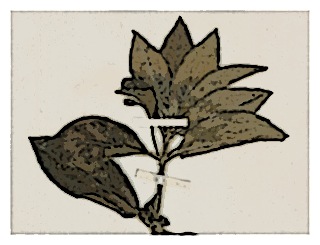
Flowers—Generally fewer than 12 per branch, axillary and pendant, pedicels pubescent, 5 to 25 (to 40) mm long, ovary ovoid-ellipsoid, strongly tetragonous, 6 to 9 mm long, 2 to 3.5 mm thick, hirsute to strigose, green to dull red, floral tube narrowly funnelform, (32 to) 36 to 50 (to 60) mm long, 3 to 4 mm wide and somewhat bulbous at the base, narrowed to 2 to 3.5 mm wide above the nectary, then gradually widened or slightly ampliate near the middle until 6 to 10 mm wide at the rim, hirsute to strigose or subglabrous outside, pilose inside for most its length, sepals (narrowly) lanceolate, acute to subacuminate at the apex, (10 to) 13 to 2 0 (to 23).mm long, 3.5 to 5 mm wide, spreading to divergent at anthesis. Tube and sepals subnitid scarlet, pink, or orange red, sepals sometimes dull, green-tipped, petals red, orbicular to obovate or broadly elliptic, rounded to (broadly) acute at the apex, (8 to) 9 to 15 mm long, (6 to) 8 to 13 mm wide, spreading to divergent at anthesis. Nectary unlobed or shallowly 4-lobed, 1.5 to 2 mm high, filaments red, 8 to 12 mm and 6 to 9 mm long, anthers oblong, 3 to 4 mm long, 1.5 to 2 mm wide, cream, style red, villous for most its length, stigma conic-globose, slightly 4-cleft apically, 2 to 3.5 mm long, 1.5 to 4 mm wide, red.
Fruit—The berry is tetragonous before maturity, subglobose to ellipsoid when ripe, 11 to 15 mm long, 7 to 9 mm thick, and red purple.
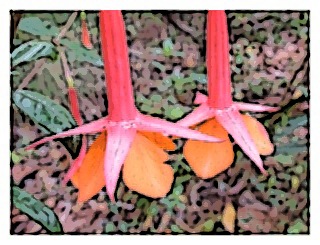
Seeds—Tan, 1.8 to 2.5 mm long, and 0.9 to 1.2 mm wide.
Chromosomes—Gametic chromosome number n = 11(?), 22.
Authors—André 1888.
Original publication—Rev. Hort. 60: 233 1888.
Synonyms—F. hitchcockii, Johnston 1925.
Herbarium Specimens—Kew; New York; Smithsonian.
F. wurdackii Munz
Northern Peru. Endemic to moist sites on slopes leading into the Rio Utcubamba valley in Amazonas Department at elevations from 2,100 to 2,400 meters.
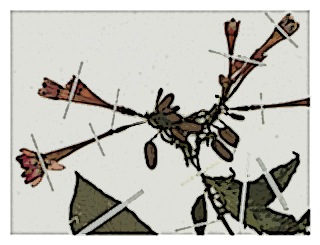
Habit—Erect shrubs one to one and half meters tall. Young growth finely pilose, older stems pilose and dull tan, 3 to 10 mm thick.
Leaves—Opposite or ternate, softly membranous, narrowly elliptic-ovate, acute to subacuminate at both ends, 7 to 18 cm long, 2 to 8 cm wide, shortly soft pilose on both sides; secondary veins 7 to 14 on either side of the midvein; margin subdenticulate. Petioles pilose, 7 to 43 mm long. Stipules conspicuous, lanceolate, usually with an obtuse apex, pale membranous, 3 to 5 mm long, 0.5 to 2 mm wide, sometimes connate, usually persistent and reflexed.
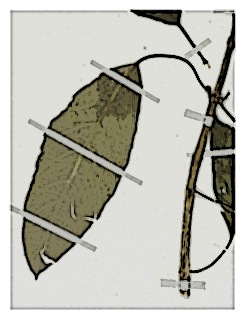
Flowers—Few to many in terminal, corymbose, drooping racemes, rachis 4 to 18 cm long, bracts lance-linear, denticulate, 15 to 50 mm long, 3 to 8 mm wide, pedicels 9 to 11 (to 25) mm long, ovary oblong, 7 to 10 mm long, 3 to 4 mm thick, floral tube narrowly funnelform, 31 to 50 mm long, 2 to 3 mm wide and slightly bulbous at the base, gradually widened above until 5 to 8 mm wide at the rim, pilose to short villous outside, pilose inside in lower ~, sepals oblong, obtuse, 9 to 16 mm long, 3 to 5 mm wide, spreading at anthesis. Tube and sepals coral red, petals red, oblong to broadly elliptic, obtuse at the apex, 11 to 20 mm long, 4 to 8 mm wide. Nectary unlobed or shallowly 4-lobed, about 1.5 mm high, filaments red, 5 to 9 mm and 3 to 6 mm long, anthers oblong, 2 to 2.5 mm long, about 1.5 mm wide, white, style red, glabrous, stigma capitate, shortly 4-lobed at the apex, 2 to 3mm long,2 to 4 mm wide, pink, exserted 1 to 3 mm beyond the anthers.
Fruit—The berry is cylindric to ellipsoid, 17 to 20 mm long, and 9 to 11 mm thick.
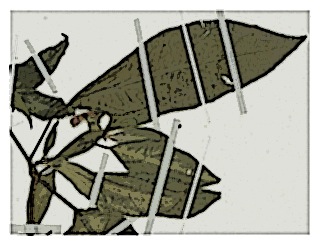
Seeds—1.6 to 2 mm long, and 0.9 to 1.2 mm wide.
Chromosomes—Gametic chromosome number n = 11.
Authors—Munz 1964.
Original publication—Brittonia 16: 229 1964.
Synonyms—None.
Herbarium Specimens—Smithsonian.
